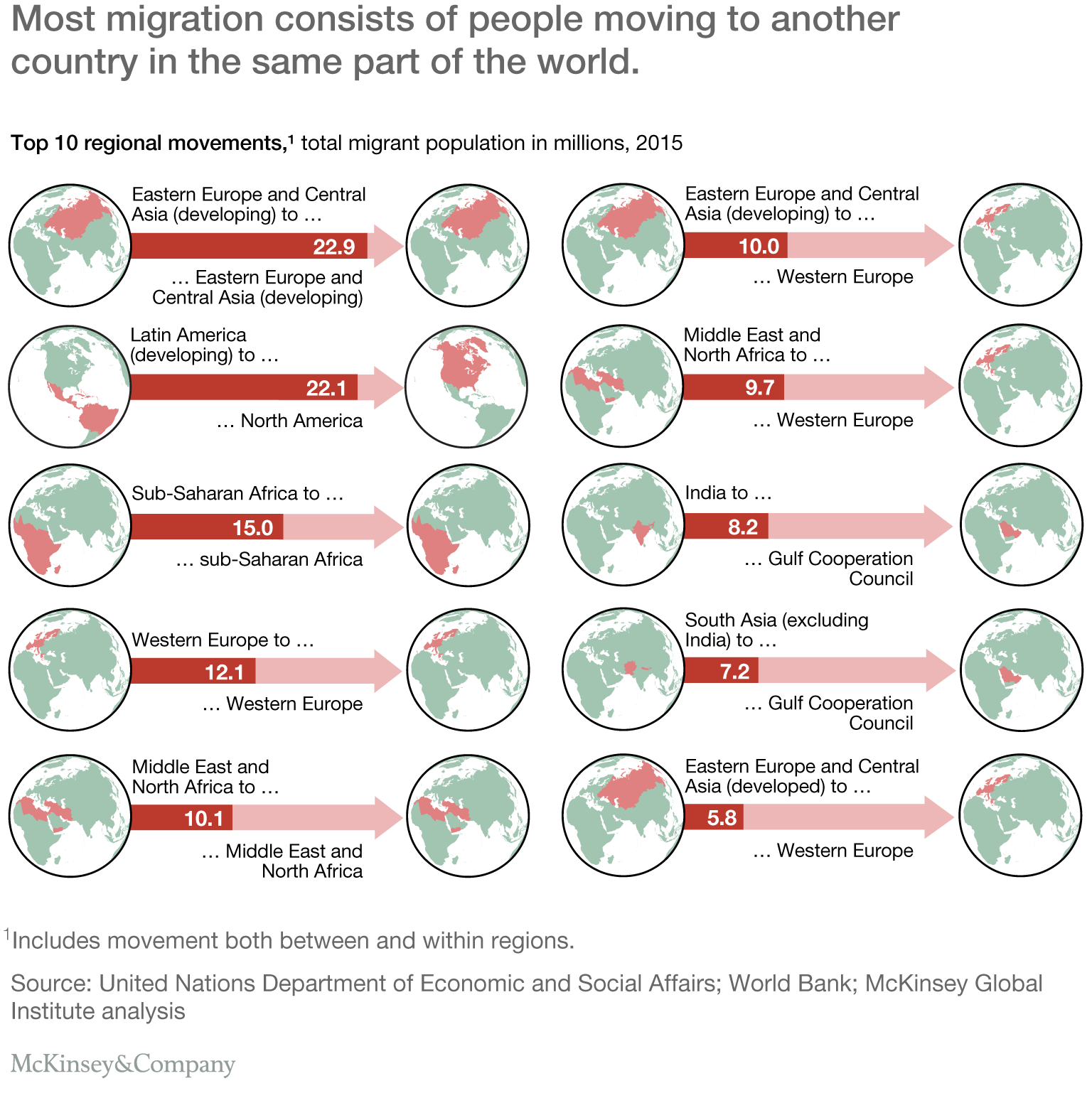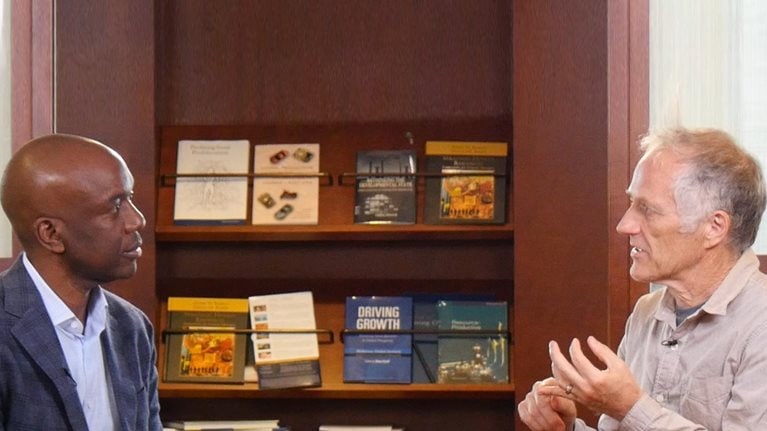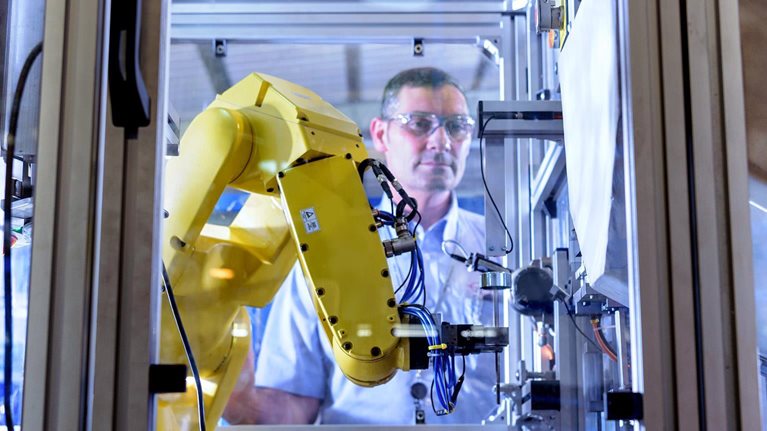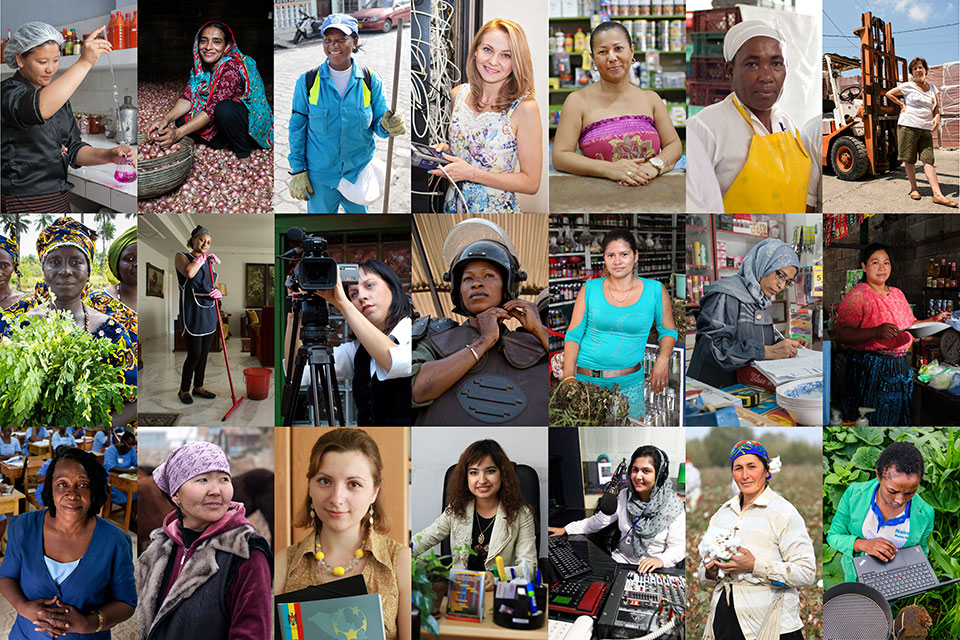

The World of Work is Rapidly Changing IELTS Essay
The world of work is rapidly changing and employees cannot depend on having the same job or the same working conditions for life. Discuss the possible causes and suggest ways to prepare people to work in the future.
Give reasons for your answer and include any relevant examples from your own knowledge or experience. You should write at least 250 words.
Practice with Expert IELTS Tutors Online
Apply Code "IELTSXPRESS20" To Get 20% off on IELTS Mock Test
This essay was asked on Recent IELTS Exam 20 January 2022 India Question Answers
The World of Work is Rapidly Changing IELTS Essay – Model Essay 1
These days, people’s workplaces are constantly changing and evolving to meet the demands of modern society. Furthermore, the roles and responsibilities of jobs are also undergoing changes to adapt to new ways of working and living. This essay will discuss the possible reasons for these changes and suggest some ways that people can better prepare themselves for their future careers.
Firstly, due to the developments in hi-tech machines and artificial intelligence, millions of people all around the world are losing their jobs and being replaced by automated processes. For example, millions of factory workers have lost their jobs because they have been replaced by machines that are able to do their job quicker and more effectively. Furthermore, as a result of the ever-increasing desire to cut expenses and increase profits, many jobs are being outsourced to countries where the wages are lower. For instance, when a person calls a tech support helpline in an English-speaking country, they will most likely be connected to someone in another country, like India or the Philippines, where the wages are lower.
However, there are a number of ways that people can prepare for changes in their workplaces in the future. Firstly, students preparing to leave high school need to be advised about the sustainability of the career path they are choosing. To illustrate, autonomous vehicles are predicted to replace most delivery and taxi driver jobs in the very near future, so this is not a job that someone should expect to have for a very long time. Furthermore, while some jobs are being replaced by technology, many jobs are simply incorporating technology into their process, and therefore people will need to be able to keep up to date with these changes. To help achieve this, specific courses could be designed to help educate people on the use of modern technology in their workplaces.
In conclusion, although there are many changes in the workplace these days, educating people to carefully choose their career and to keep up to date with modern technology, is the key to avoiding any major problems.
I E L T S XPRESS
The World of Work is Changing Rapidly Essay – Model Essay 2
It is irrefutable that the work scenario is altering at a fast pace. Working conditions are also different and the process of job-hopping is very common. This essay shall delve into the possible causes for these changes and suggest ways to prepare for work in the time to come.
To begin with, the development of science and technology has changed the structure of work. For example, people no longer need to do some heavy work by themselves. Instead, they can use machines. Secondly, competition has become intense and people have to constantly update themselves with the latest materials and methods. Sometimes they cannot compete with the new techno-savvy workforce and so have to change jobs out of compulsion.
Furthermore, we belong to an era of consumerism. Being surrounded by so many choices, people today want to buy new things and for that, they do multiple jobs. In addition, the 24/7 society of today provides us the opportunity to work day and night. For instance, in earlier times, there were very few jobs which were round-the-clock jobs. But, today, globalization has brought in a multitude of options of working day and night. The line between day and night has become dim and people have become workaholics.
There could be many suggestions to prepare for work in the future. People should have a set goal in their mind and get training accordingly. Moreover, it is important to draw a line somewhere. The stress and strain of the fast modern workplace is leading many to nervous breakdowns. In the developed countries, a new term called downshifting has already come where after a certain stage, people are saying ‘no’ to promotions and showing contentment with less. We should also realize that if we stick to one job, then also life can be more stable and we can enjoy our leisure also. ieltsxpress
To put in a nutshell, I pen down saying that, although work conditions are different today and we have a need to update our knowledge regularly, we can plan our life in a meticulous way and have a balance between work and leisure.
Also Check: There is a General Increase in Anti-Social Behaviour Essay
IELTS Writing Task 2 on Jobs – Model Essay 3
In today’s modern world, people tend to change jobs more often than before and don’t want to work permanently in one environment. I would like to explore the sources of this issue and suggest several solutions for future work.
Firstly, due to the global recession, many employers have to downsize and restructure their businesses. This leads to a number of redundant employees being forced to leave their jobs and find other ones. Another reason is that, as living costs are getting higher and higher, people want to earn as much money as they can to meet their needs. Hence, they seek better opportunities and well-paid jobs everywhere, every day. Some also look for new challenges. Last but not least, thanks to new technology, people nowadays are able to access information more easily, including information about job recruiting.
One of my suggestions for this problem is that if we can create a comfortable working environment and build strong relationships between colleagues; and between managers and workers. These will make employees find it harder to leave. To archive this, courses such as leadership training and communication skill training should be carried out to help supervisors lead their team efficiently without causing any stress, and help employees fit inconveniently. ielts xpress
By the way of conclusion, I would like to state that change job is one the remarkable signs of technological times and soft skill training courses possibly help people adapt to the working environment instead of finding a way to escape it.
The Workplace is Changing Rapidly – Model Essay 4
Work culture lately has been dynamically transformed, mainly due to improvements in technology like transport and communication. Job security has become a dicey issue as employees now need to keep themselves updated with the advancements around them. This essay shall further explain the reasons and offer probable solutions. ieltsxpress.com
In the last two decades, we have seen a remarkable spread of technology in all wakes of life. With easy access to the Internet and computers, work has become faster and easier. Innovation of office tools is encouraged everywhere so as to not let anything hinder the growth of trade and commerce. With each task becoming effortless, manual intervention at many places has been reduced. Ergo, rising insecurity is seen among employees. Additionally, employees are expected to multi-task in their jobs making it more difficult for older workers to sustain.
The remedial measures for such a situation are very few as of now. First of all, state-of-the-art employee training centers to help the employees stay well-versed with the high-tech upgradations. To solve this problem from an earlier level, universities should start imparting practical training in their curriculum, with the know-how of current on-the-job scenarios to prepare potential workers better. All this needs to be done as the employees losing their jobs also lose financial security for their families, and it is very difficult to start again from ground zero.
To conclude, I’d say we should accept the ever-changing technological advancements as they’re unlikely to stop. Better would be to equip ourselves and become flexible accordingly so as to welcome such developments.
How The World of Work is Changing – Model Essay 5
It is indeed true that the world has been increasing by loops and bound for a long time and very few employees can handle obstacles in their near future. Because it has some reason. However, to my notion, employees need some specification training for it.
There are various reasons behind why it has increased, first and foremost, in globalization time every company wants to grow fast. Secondly, important roles are being played by studying on the contemporary world. that is why every employee ought to be cognizant of every field. so that he/she can do everything for their job. Moreover, technology has changed every life completely. for instance mobile, internet and computer are very prominent in the work field. it helps the employee to make their job easy. Finally, in today’s time, we can see a person living in India and working for a company located in us.
on contrary, every problem has a solution there is some way which can help employees for their job. to start with they must be taught English because English is a basic requirement for learning any new thing. Moreover, they must be friendly with their peer group members. in addition, management skills, internet, and computer knowledge must be important. these all things give help them in their upcoming time.
To sum up, I firmly believe that there are ample chances in today’s work environment. However, by following some training. we can prepare employees for the near future growth and make spectacular culture.
Ideas for World of Work
Also Check: It is Impossible to help all people in the world IELTS Essay
Oh hi there! It’s nice to meet you.
Sign up to receive awesome content in your inbox, every week.
We promise not to spam you or share your Data. 🙂
Check your inbox or spam folder to confirm your subscription.

Oh Hi there! It’s nice to meet you.
We promise not to Spam or Share your Data. 🙂
Related Posts

Some Countries Spend a lot of Money to Make Bicycle Usage Easier

Tasks at Home and Work are being performed by Robots

Climate has the Greatest Effect on People’s Way of Life
Leave a comment cancel reply.
Your email address will not be published. Required fields are marked *
Yes, add me to your mailing list
Start typing and press enter to search

Band 8+: The world of work is changing rapidly and employees cannot depend on having the same job or the same working conditions for life. Discuss the possible causes for this rapid change, and suggest ways of preparing people for the world of work in the future.
In recent years, numerous dramatic changes have occurred for different jobs, leading to difficulties for employees. While there are many factors contributing to this trend, some reasonable approaches can be adopted to tackle the problem.
The way employees work and their prospects have been significantly influenced by recent advancements in technology. These improvements not only have put some jobs in danger, but also have obviously altered the method of working. Following the aforementioned process, many tasks, entirely or partially, rely on computers and machines. For example, many factories are excessively using robots to produce their products, resulting in the loss of jobs of many former workers. In addition, digital technology has offered remote working for many employees, leading to a more competitive atmosphere for such careers, and subsequent feeling of job instability and insecurity.
However, employees can foster their skills in new in-demand jobs to enhance their opportunity to cope with the new situation. Providing such a pragmatic strategy will substantially diminish the detrimental effects of the phenomenon. Various types of work, including management, web designing and art are only a few examples of those abilities that will not be adversely affected by digital and technological advancements. The proficiency in such work heightens a prosperous future for employees, and makes their minds free of ordinary tasks, which will be properly done by machines, encouraging them to explore their innovative ideas.
In conclusion, although an inevitable changing process has occurred in many jobs, the side effects for the workforce can be alleviated by utilizing sensible policies.
Check Your Own Essay On This Topic?
Generate a band-9 sample with your idea, overall band score, task response, coherence & cohesion, lexical resource, grammatical range & accuracy, essays on the same topic:, the world of work is changing rapidly and employees cannot depend on having the same job or the same working conditions for life. discuss the possible causes for this rapid change, and suggest ways of preparing people for the world of work in the future..
The dynamic landscape of work is undergoing rapid transformations, driven primarily by the relentless progress of technology. It is widely accepted that job security and stable working conditions are no longer guaranteed for employees over their lifetime. The imperative of adapting to constant change is crucial in remaining competitive in today’s society. One of the […]
The world of work is undergoing significant transformation due to globalization and technological advancement. The rise of artificial intelligence and robotic automation have highly influenced the world of work, leading people to rethink their job security. This evolving landscape has created a sense of uncertainty among workers, urging them to adapt and upgrade their skills […]
This essay analyses which are the main causes of why working life is changing more and more every day, but at the same time people are not well prepared for these changes. some of the possible reasons why this is happening are the big economic fluctuations of these last years and with this also the […]
Nowadays, the world of work is changing rapidly which has negative influences on employees. This problem has several reasons. In following essay, I will discuss about the cause of issue and I believe that the best way to help workers can find a better job is enhance their skills. The primary reason why the work […]
The rapid evolution of the world of work stems from a confluence of factors, necessitating a fundamental shift in how individuals approach their careers. Technological advancements, globalization, demographic shifts, and economic uncertainty are among the primary drivers of this change. Firstly, technological innovations such as automation, artificial intelligence, and robotics have transformed industries, altering job […]
Other Topics:
It is sometimes said that countries should produce all the food for their populations to eat and import as little as possible..
It is believed that countries should only meet the domestic food supply and restrict import owing to the consistent price. While this idea has some merits, I partly disagree with it due to several economic and social considerations. On the one hand, it is undenieable that a country producing food for itself would reduce the […]
Studies have suggested that nowadays children watch much more television than they did in the past and spend less time on active or creative things. What are the reasons for this and what measures should be taken to encourage children to spend more time on active or creative things?
It is true that recently addiction to technological devices among children has immensely increased, which leads to the depletion of imaginative and active time.While there will undoubtedly be some primary causes of this, families can take steps to mitigate these potential problems. As the world is modernizing, eventually technological devices become a demand in everyone’s […]
Some students choose to work or travel after leaving school and before going to university. Many people, however, say that working experience is more useful in adult life than travel. To what extent do you agree or disagree?
These days, young people have more freedom of choice in learning and working. Some students prefer to work after graduating high school, while on the contrary, many people prefer to travel around the world before entering the university. From my point of view, I partly agree with the initial statement due to both of the […]
Why the number of animals and plants is declining in many countries? What are the solutions to this?
The last decades have seen a reduction in the number of animals and green areas. From my point of view, although there are a number of factors contributing to this phenomenon, it could be mitigated by governments by taking some proper measures. There might be two major factors that are causing the reduction of the […]
Q. Education of young people is highly prioritized in many countries. However, educating adults who cannot write or read is even more important and governments should spend more money on this. To what extent do you agree or disagree?
It is often argued that in some nations, youth’s are first priority in education sector while some argue that education required for older generation, those who cannot read or write. The authority should have to spend a vast amount of money behind them. I completely disagree with this statement. First of all, youngsters have more […]
Some people believe that the best way to provide a happier society is to ensure that there are only small differences between the richest and poorest members. To what extent do you agree or disagree?
Some people believe that people can make a happy society , it needs to be sure if it is true that the difference between richest and poorest with income is just a few . Personally, I entirely disagree with this statement for some reasons I will elaborate more below. For a variety of reasons, it […]
Plans & Pricing
Five key trends shaping the new world of work

Job seekers in companies in regions most affected by high unemployment rates must broaden their horizons beyond a search for employment opportunities to exploring work opportunities. Image: Alex Kotliarskyi for Unsplash
.chakra .wef-1c7l3mo{-webkit-transition:all 0.15s ease-out;transition:all 0.15s ease-out;cursor:pointer;-webkit-text-decoration:none;text-decoration:none;outline:none;color:inherit;}.chakra .wef-1c7l3mo:hover,.chakra .wef-1c7l3mo[data-hover]{-webkit-text-decoration:underline;text-decoration:underline;}.chakra .wef-1c7l3mo:focus,.chakra .wef-1c7l3mo[data-focus]{box-shadow:0 0 0 3px rgba(168,203,251,0.5);} Segun Ogunwale

.chakra .wef-9dduvl{margin-top:16px;margin-bottom:16px;line-height:1.388;font-size:1.25rem;}@media screen and (min-width:56.5rem){.chakra .wef-9dduvl{font-size:1.125rem;}} Explore and monitor how .chakra .wef-15eoq1r{margin-top:16px;margin-bottom:16px;line-height:1.388;font-size:1.25rem;color:#F7DB5E;}@media screen and (min-width:56.5rem){.chakra .wef-15eoq1r{font-size:1.125rem;}} Future of Work is affecting economies, industries and global issues

.chakra .wef-1nk5u5d{margin-top:16px;margin-bottom:16px;line-height:1.388;color:#2846F8;font-size:1.25rem;}@media screen and (min-width:56.5rem){.chakra .wef-1nk5u5d{font-size:1.125rem;}} Get involved with our crowdsourced digital platform to deliver impact at scale
Stay up to date:, future of work.
Listen to the article
- There is transformation happening in the world of work, both as a result of the pandemic, and underlying structural shifts.
- Companies are restructuring for efficiency, and recruiting for skills rather than potential, while talent is highly mobile.
- Digital skills are increasingly central to workers' employability.
From the phenomenon of " quiet quitting " to the great resignation , the post-pandemic reluctance of workers to return for the office has been well documented . There are other changes happening as a result of the subsequent economic slowdown: employment offers have been rescinded amidst layoffs in technology companies often seen as beacons of growth, and a STEM skills shortage has led to calls for upskilling and re-skilling programmes in the workplace and a global scramble for talent . But many of the trends we are currently seeing in the world of work predate the COVID-19 pandemic. Here are five shifts that look set to endure:
1. Restructuring companies for efficiency
Changes to industry structures and disruptions to business models have encouraged companies to restructure for relevance and competitiveness. Companies such as General Electric have split while others have responded with mergers, as in the case of Tata Group . Holding companies that have been able to do without job cuts, like Alphabet, are calling for an increase in employee productivity .
Have you read?
Hybrid entrepreneurship - 5 reasons to build a venture while still working , what is the optimal balance between in-person and remote working, a new study shows just how beneficial remote working can be.
Despite capital flow to many emerging markets, several industries remain informal, fragmented, and dominated by Small and Medium Enterprises (SMEs) , which create 7 out of 10 jobs. Irrespective of the market, industry and approach, the pursuit of efficiency in companies prioritise retention and hiring of employees with skills and competencies that contribute directly to the bottom line.
2. A shift to skills-based hiring
Faced with the need to deliver short to medium-term results, companies are increasingly hiring for skills backed with experience, and less for potential. This has led to a decline in graduate recruitment . Many employers are eliminating degrees from their hiring criteria in favour of skills assessment. Only 11% of business leaders “strongly agree” that students are graduating from higher education with the necessary competencies. This has led to calls for higher education reform .
Young people entering the world of work have to embrace work-integrated learning opportunities available as internships, placements, and apprenticeship programmes to provide relevant experience in developing their skills. More than four in five employers believe internships can prepare graduates to succeed in their companies.

3. The mobility of talent
The global war for skilled talent has led to massive opportunities for some workers to move across jobs, industries and countries. The normalization of remote work accelerated by the COVID-19 pandemic and powered by digital technologies for collaboration has made it possible for top talent to glide across jobs or be in multiple jobs at a time. Research predicts that today’s youngest workers will hold twelve to fifteen jobs in their lifetime .
Therefore, individuals and companies must evaluate their work opportunities from a broader and global lens, shifting to a mindset of career mobility and the development of transferable skills for a lifetime of numerous job opportunities. At the same time, the future looks likely to hold higher trade tariffs and tighter border controls, and we have yet to see what this means for worker mobility.

4. The rise of 'work' and the decline of 'employment'
The rise of platform companies has fundamentally changed the rules of employment . Companies such as Uber have created work opportunities for around 5 million drivers worldwide without signing a single driver employment contract. The gig economy has opened up opportunities for individuals and companies to access a diverse and global pool of talents to get tasks done on demand - as well as undermining many of the structures that have underpinned employment security.
This has changed how organizations approach recruitment, with a move away from human resources departments managing employees, and towards talent strategy teams exploring how to meet human resources needs. Analytic tools to measure performance enable a holistic view of talent management in the workplace. Job seekers in companies in regions most affected by high unemployment rates must broaden their horizons beyond a search for employment opportunities to exploring work opportunities. Regulators in industries dominated by platform companies need to push for benefits to be tied to work opportunities, not just employment, to protect the interest of workers.

5. The central importance of digital skills
The digital transformation of industries has brought about massive shifts in the world of work. Organizations across all sectors, from agribusiness, finance and manufacturing to media, are evolving into technology companies . In this context, 'employability' is not just about 'soft skills' such as communication, collaboration, critical thinking and emotional intelligence. As digital platforms in AI applications, robotics, and the Internet of Things make inroads into the workplace, employability skills will be increasingly centred around using these digital technologies at work.
Don't miss any update on this topic
Create a free account and access your personalized content collection with our latest publications and analyses.
License and Republishing
World Economic Forum articles may be republished in accordance with the Creative Commons Attribution-NonCommercial-NoDerivatives 4.0 International Public License, and in accordance with our Terms of Use.
The views expressed in this article are those of the author alone and not the World Economic Forum.
The Agenda .chakra .wef-n7bacu{margin-top:16px;margin-bottom:16px;line-height:1.388;font-weight:400;} Weekly
A weekly update of the most important issues driving the global agenda
.chakra .wef-1dtnjt5{display:-webkit-box;display:-webkit-flex;display:-ms-flexbox;display:flex;-webkit-align-items:center;-webkit-box-align:center;-ms-flex-align:center;align-items:center;-webkit-flex-wrap:wrap;-ms-flex-wrap:wrap;flex-wrap:wrap;} More on Jobs and the Future of Work .chakra .wef-nr1rr4{display:-webkit-inline-box;display:-webkit-inline-flex;display:-ms-inline-flexbox;display:inline-flex;white-space:normal;vertical-align:middle;text-transform:uppercase;font-size:0.75rem;border-radius:0.25rem;font-weight:700;-webkit-align-items:center;-webkit-box-align:center;-ms-flex-align:center;align-items:center;line-height:1.2;-webkit-letter-spacing:1.25px;-moz-letter-spacing:1.25px;-ms-letter-spacing:1.25px;letter-spacing:1.25px;background:none;padding:0px;color:#B3B3B3;-webkit-box-decoration-break:clone;box-decoration-break:clone;-webkit-box-decoration-break:clone;}@media screen and (min-width:37.5rem){.chakra .wef-nr1rr4{font-size:0.875rem;}}@media screen and (min-width:56.5rem){.chakra .wef-nr1rr4{font-size:1rem;}} See all

Why companies who pay a living wage create wider societal benefits
Sanda Ojiambo
May 14, 2024

Age diversity will define the workforce of the future. Here’s why
Susan Taylor Martin
May 8, 2024

From start-ups to digital jobs: Here’s what global leaders think will drive maximum job creation
Simon Torkington
May 1, 2024

70% of workers are at risk of climate-related health hazards, says the ILO
Johnny Wood

International Workers' Day: 3 ways trade unions are driving social progress
Giannis Moschos

Policy tools for better labour outcomes
Maria Mexi and Mekhla Jha
April 30, 2024
The Future of Work
- Climate Solutions
- Commencement 2024
The global pandemic changed the way we work and how our workplaces function. Our experts investigate what changes may be here to stay and what else to expect in the future.
The future is calling
Work is beginning to look very different across all fields and around the globe.
Will we all go back? Will they ever be the same?
What can we learn from the pandemic?
Internships
How can we make them more equitable?
What will digital health care look like?
Can technology help farmers connect to their customers?
Is the open office a thing of the past?
Which skills have staying power in this rapidly changing market?
Global talent
How do you attract talent from around the world?
Legal professionals
Will online litigation help our clogged courts?
What is “The Great Resignation”?
Harvard economist Lawrence Katz explains some of the factors that led to the highest quit rate in US history.
Well-being at work
Business owners, employees, and researchers are looking at ways to make workplaces safer and healthier.
Predictable scheduling
Requiring more notice in scheduling for hourly workers results in more predictable shifts and increased stability for workers, which also leads to improvements in worker well-being, sleep quality, and economic security.
Air quality
The air quality in an office can have significant impacts on employees’ cognitive function, including response times and ability to focus, and it may also affect their productivity, according to new research.
Worker safety and health
COVID-19 forced companies to act quickly and decisively to keep workers safe, and employers have had to adapt new business processes and address existing structures that are lacking.
Flexibility
While working from home, employees have enjoyed an unprecedented sense of agency and autonomy. Contrary to some expectations—but consistent with years of research—that flexibility has actually spurred worker productivity to improve.
For a broader view on workplace innovations, explore the work of our experts from a variety of institutes and centers including:
- The Project on Workforce
- GrowthPolicy
- Harvard i-lab
- Center for Work, Health, & Well-being
- Corporate Responsibility Initiative
- Labor and Worklife Program
- Working Knowledge
- The Institute for Strategy and Competitiveness

Harvard Business School
Managing the future of work
Co-chaired by William R. Kerr and Joseph B. Fuller, this project explores solutions and adaptations to rapid technological change, shifting global product and labor markets, evolving regulatory regimes, outsourcing, and the fast emergence of the gig economy.
Learn more from the Business School
Explore the podcast

Harvard Kennedy School
Reimagine the world of work
Experts investigate ways to help workers gain new skills, get companies to drop outdated practices, and other forward thinking ideas.
Learn more from the Kennedy School
Graduate School of Education
Reshaping work
Experts discuss how the pandemic is altering jobs and careers and how education can respond.
YOU MAY ALSO LIKE
Related In Focus topics
- Coronavirus
- The Accessible World
- Listening Tests
- Reading Tests
- IELTS Writing Checker
- IELTS Writing Samples
- Free IELTS Speaking Test Online
- Speaking Club
- Vocabularying
- 2024 © IELTSing
- free ielts Listening test practice 2024 with answers
- free ielts Reading tests online 2024 with answers
- Free IELTS Writing Checker
- Check IELTS Speaking Test

The world of work is changing rapidly so people cannot always depend on their jobs. What are the reasons and offer some measured to solve this

IELTS essay The world of work is changing rapidly so people cannot always depend on their jobs. What are the reasons and offer some measured to solve this
- The graph below shows the number of students from the US, the UK and Australia who studied in universities in other countries from 2002 to 2007. The line graph illustrates the number of American, British and Australian students who studied in universities in other nations between 2002 and 2007. Overall, The maximum number of American students and the least number of Australian students studied away from their home country while, the number o ...
- Most people in the world have to work to earn a living. However, many people work only for the financial gain that it involves, and not for any other rewards that a job can offer. What do you think the main consideration when deciding what job to take should be? While almost everyone must work to earn a living, people have different value system when deciding what sort of job to do. some have the predominant aim of earning as much money as possible. other make their choice based on what they love to do. while there is more than one way for people to build a ...
- SOME PEOPLE FEEL THAT IMAGE IS MORE EFFECTIVE AS COMPARED TO WRITTEN WORD. TO WHAT EXTENT DO YOU AGREE In a technological society, controversy continues to persist on which has superiority, between using media such as photographs and movies for communication, as compared with the conventional written method. In my opinion, while media has its fascinative usefulness, written word continues to be more ...
- Write a letter to your boss for missing the meeting Respected sir, I feel extremely apologetic for missing the morning meeting you had planned along with all the stake holders. I realize that I have made a mistake which could have led to severe consequences. I would like to thank you at the same time for not punishing me and supporting me infront of ...
- Tourism has emerged as one of the biggest industries of this decade but it’s disadvantages cannot be overlooked. with this statement. Tourism plays a vital role in generating income for the nation. Technological advancements have made tourism a booming industry, as it acts as a valuable source of foreign exchange for the government. Though there are certain disadvantages, it could be minimised if proper measures are taken. Hence, ...
- In recent times, more people are preferring image such as photo and video over written word. They feel image is a more powerful way of communicating. In a technological society, controversy continues to persist on which has superiority, between using media such as photographs and movies for communication, as compared with the conventional written method. In my opinion, while media has its usefulness, written word continues to be more reliable, he ...
- Crimes are increasing day by day. What are the reasons behind it and how can we solve it. Acceleration in crime has become one of the major concern nowadays due to uneducated adolescents. However, youngsters are the victims of criminal Activities more than another age group of people who, doing these anti-social acts. I would briefly explain some tremendous causes that why crimes rates a ...
- Nowadays people prefer to shop in large supermarkets rather than nearby local shops. why do you think this is happening. Is this a positive or a negative tread. In the modern era, people preferred big shopping malls rather than public shops. It demonstrates a plethora of reasons behind this. Personally, I reckon that both shopping places have their own merits and demerits. On the one hand, the branded showroom comprises a number of arrangements like a huge ...
- What are the causes of these similarities? Do you think that the advantages of these similarities outweigh the disadvantages? Global tourism is enjoying an upsurge in popularity nowadays. However, this trend is accompanied by many complaints that similarities of the landscapes considerably reduce the delights and attractions of the travel. Globalisation, in my mind, is the greatest reason for the similarities. No doubt, g ...
- Hiring New Employees What is involved in hiring new employees? What are some options for hiring employees? The ability to successfully hire staff is critical to a company's success. During the screening process, prospective applicants are sought out, and during the screening process, the best candidates for employment are identified. Hiring new employees start with posting a job advertisement. It can be ...
- In Some Countries, Most People Prefer To Rent Homes Rather Than Buy Them Recently, most people like renting a house instead of owning it. Some people have a limited amount of time to buy house. The choice of renting a place to stay will be more affordable with price ranges and there's a wider variety of locations available. Renting a house, a flat or a condo has many ad ...
- Some people think that government should provide free education in all level. But some says university fees should be payed by children. Discuss it is undeniable that education is fundamental right of every child. There some population believe that it should be given freely to every child in every level. But few people argue that graduation studies should be afforded by children themselves. The main reason for why people say to support all ...
Technology, jobs, and the future of work
The world of work is in a state of flux, which is causing considerable anxiety—and with good reason. There is growing polarization of labor-market opportunities between high- and low-skill jobs, unemployment and underemployment especially among young people, stagnating incomes for a large proportion of households, and income inequality. Migration and its effects on jobs has become a sensitive political issue in many advanced economies. And from Mumbai to Manchester, public debate rages about the future of work and whether there will be enough jobs to gainfully employ everyone.
The development of automation enabled by technologies including robotics and artificial intelligence brings the promise of higher productivity (and with productivity, economic growth), increased efficiencies, safety, and convenience. But these technologies also raise difficult questions about the broader impact of automation on jobs, skills, wages, and the nature of work itself.
Many activities that workers carry out today have the potential to be automated. At the same time, job-matching sites such as LinkedIn and Monster are changing and expanding the way individuals look for work and companies identify and recruit talent. Independent workers are increasingly choosing to offer their services on digital platforms including Upwork, Uber, and Etsy and, in the process, challenging conventional ideas about how and where work is undertaken.
For policy makers, business leaders, and workers themselves, these shifts create considerable uncertainty, alongside the potential benefits. This briefing note aims to provide a fact base on the multiple trends and forces buffeting the world of work drawing on recent research by the McKinsey Global Institute and others.
Table of contents
Developments in employment, income, and skills
How automation and technology are affecting work, the challenges of digitization—and possible solutions.

Challenges in labor markets are growing, household incomes in advanced economies have been stagnating, and there are increasing skill gaps among workers.
Labor markets are under strain, and talent is underutilized
Unemployment and underemployment are high around the world. In the United States and the 15 core European Union countries (EU-15), there are 285 million adults who are not in the labor force—and at least 100 million of them would like to work more. Some 30 to 45 percent of the working-age population around the world is underutilized—that is, unemployed, inactive, or underemployed. This translates into some 850 million people in the United States, the United Kingdom, Germany, Japan, Brazil, China, and India alone. Most attention is paid to the unemployed portion of this number, and not enough to the underemployed and the inactive portions, which make up the majority of untapped human potential.
Almost 75 million youth are officially unemployed. Women represent one of the largest pools of untapped labor: globally, 655 million fewer women are economically active than men. In a “best-in-region” scenario in which all countries match the rate of improvement in gender gaps (in labor force participation, hours worked, and sector mix of employment) of the best-performing country in their region, $12 trillion more of annual GDP would be realized in 2025 , equivalent in size to the current GDP of Japan, Germany, and the United Kingdom combined.
Household incomes in advanced economies have stagnated or fallen, fueling public disgruntlement
The vast majority of people derive incomes from jobs. In the United States, Western Europe, and across advanced economies, market incomes (from wages and capital) stagnated or fell for about two-thirds of households in 2005–14, a period marked by deep recession and slow recovery after the 2008 financial crisis. This was the first time incomes stopped advancing on such a scale since the stagflation era of the 1970s, and it may have helped stir popular opposition to globalization. The recession was a leading cause of the abrupt end to income advancement, but other longer-run factors also contributed, including a decline in the share of national income that is paid to workers, the so-called wage share. This has fallen across advanced economies despite rising productivity, suggesting a decoupling between productivity and incomes.
The decline is due in part to the growth of corporate profits as a share of national income, rising capital returns to technology investments, lower returns to labor from increased trade, rising rent incomes from home ownership, and increased depreciation on capital. Policy makers in the affected countries took action during the downturn to compensate for the income squeeze, in the former of lower taxes and higher transfers, but these were largely one-off measures to buoy disposable income in response to the recession, and not sustainable.
Globalization has brought numerous benefits, including lifting millions of people in emerging economies into the consuming class. But it also has had an impact in some sectors like manufacturing in advanced economies, with some jobs moving offshore. Better support could have been provided to help affected workers build new skills and transition into new sectors or occupations.
A survey we conducted in France, the United Kingdom, and the United States showed a significant proportion of those whose incomes stagnated are worried about their children’s economic prospects—a sharp departure after many decades in which it was an article of faith that every generation would enjoy higher living standards than their parents. Middle-income households have been the most affected, and young and less educated people are especially vulnerable. Across all age groups, medium- and low-skill workers have done worse than those with a college education. Many blame governments, global institutions, corporations, and establishment “elites” around the world, and the principles of free trade and open borders are under attack.

Getting practical about the future of work
Skills, jobs, and locations do not always match, limiting income-earning opportunities for many.
Educational systems have not kept pace with the changing nature of work, resulting in many employers saying they cannot find enough workers with the skills they need. In a McKinsey survey of young people and employers in nine countries, 40 percent of employers said lack of skills was the main reason for entry-level job vacancies. Sixty percent said that new graduates were not adequately prepared for the world of work. There were gaps in technical skills such as STEM subject degrees but also in soft skills such as communication, teamwork, and punctuality. Conversely, even those in work may not be realizing their potential. In a recent global survey of job seekers conducted by LinkedIn, 37 percent of respondents said their current job does not fully utilize their skills or provide enough challenge.
Some of the mismatching is locational: where there is demand for work, there may not be available and qualified workers to be found. This geographic mismatch can be seen across regions within countries, and between countries.
Cross-border migration fills some skill gaps but can create tensions
Cross-border migration has been a natural consequence of a world in which people do not find attractive work opportunities in their country of origin, at a time when other economies are not adequately filling their skills gaps. Migration boosts global productivity , but its consequences are often feared by native workers, who face labor market disconnects and a lack of well-paid jobs.
In 2015, approximately 247 million people lived in a country not of their birth—a number that has almost tripled in the past 50 years. Most have gravitated to places where they believe they will find better jobs . More than 90 percent have moved voluntarily, and about half have moved from developing to developed countries. In the period 2000 to 2014, migration has provided about 40 percent of labor force growth in Canada, Spain, the United Kingdom, and the United States.

Migrants made an absolute contribution to global output of roughly $6.7 trillion, or 9.4 percent of global GDP in 2015. However, migrant workers, on average, earn wages that are 20 to 30 percent lower than those of comparable native-born workers. More effective integration approaches could lay the groundwork for economic gains of up to $1 trillion globally, benefiting both economies and individuals.
In the context of challenging labor market conditions, popular sentiment has moved against immigration. Surveys conducted by MGI suggest that a significant proportion of middle- and low-income groups in advanced economies who are experiencing flat or falling real incomes are pessimistic about the future and likely to hold particularly negative views about immigrants.
Back to top

New technologies have the potential to upend much of what we know about the way people work. But disruption is an opportunity as well as a challenge—given the promise of digital talent platforms and new options for independent work, for example.
Many activities that workers carry out today have the potential to be automated
Technological change has reshaped the workplace continually over the past two centuries since the Industrial Revolution, but the speed with which automation technologies are developing today, and the scale at which they could disrupt the world of work, are largely without precedent.
MGI research on the automation potential of the global economy, focusing on 46 countries representing about 80 percent of the global workforce, has examined more than 2,000 work activities and quantified the technical feasibility of automating each of them. The proportion of occupations that can be fully automated using currently demonstrated technology is actually small—less than 5 percent. An additional important finding is that even if whole occupations are not automated, partial automation (where only some activities that make up an occupation are automated) will affect almost all occupations to a greater or lesser degree. The impact will be felt not just by factory workers and clerks but also by landscape gardeners and dental lab technicians, fashion designers, insurance sales representatives, and even CEOs.
We find that about 60 percent of all occupations have at least 30 percent of activities that are technically automatable , based on currently demonstrated technologies. This means that most occupations will change, and more people will have to work with technology. Highly skilled workers working with technology will benefit. While low-skilled workers working with technology will be able to achieve more in terms of output and productivity, these workers may experience wage pressure, given the potentially larger supply of similarly low-skilled workers, unless demand for the occupation grows more than the expansion in labor supply.
On a global scale, we calculate that the adaptation of currently demonstrated automation technologies could affect 50 percent of the world economy , or 1.2 billion employees and $14.6 trillion in wages. Just four countries—China, India, Japan, and the United States—account for just over half of these totals. There are sizable differences in automation potential between countries, based mainly on the structure of their economies, the relative level of wages, and the size and dynamics of the workforce.
As machines evolve and acquire more advanced performance capabilities that match or exceed human capabilities, the adoption of automation will pick up. However, the technical feasibility to automate does not automatically translate into the deployment of automation in the workplace and the automation of jobs. Technical potential is only the first of several elements that must be considered. A second element is the cost of developing and deploying both the hardware and the software for automation. The supply-and-demand dynamics of labor are a third factor: if workers with sufficient skills for the given occupation are in abundant supply and significantly less expensive than automation, this could slow the rate of adoption. A fourth to be considered are the benefits of automation beyond labor substitution—including higher levels of output, better quality and fewer errors, and capabilities that surpass human ability.
Finally, regulatory and social issues, such as the degree to which machines are acceptable in any particular setting, must also be weighed. It is for these various reasons that go beyond purely technical feasibility of automation that our estimates for “whole-job” automation are lower than other estimates. Our scenarios suggest that it may take at least two decades before automation reaches 50 percent of all of today’s work activities, taking into account regions where wages are relatively low.
Technology can help labor markets: Digital talent platforms improve matching between workers and jobs
Digital talent platforms have the potential to improve the ways workers and jobs are matched, creating transparency and efficiency in labor markets, and potentially raising GDP. They can raise labor participation and working hours; evidence from around the world suggests that some people would work more hours if they could. A US survey, for example, reports that three-quarters of stay-at-home mothers would be likely to work if they had flexible options. Even if a small fraction of inactive youth and adults use these platforms to work a few hours per week, the economic impact would be significant.
With their powerful search capabilities and sophisticated screening algorithms, online talent platforms can also speed the hiring process and cut the time individuals spend searching between jobs, reducing unemployment. By aggregating data on candidates and job openings across entire countries or regions, they may address some geographic mismatches and enable matches that otherwise would not have come about.
Finally, online talent platforms help put the right people in the right jobs, thereby increasing their productivity along with their job satisfaction. They can draw people who are engaged in informal work into formal employment, especially in emerging economies. Both of these effects could increase output per worker, raising global GDP.
Digitally-enabled independent work is on the rise
While independent work is nothing new (and self-employment is still the predominant form of work in emerging economies), the digital enablement of it is. MGI research finds that 20 to 30 percent of the working age population in the United States and the European Union is engaged in independent work . Just over half of these workers supplement their income and have traditional jobs, or are students, retirees, or caregivers. While 70 percent choose this type of work, 30 percent use it out of necessity because they cannot find a traditional job at all, or one that meets their income and flexibility needs. The proportion of independent work that is conducted on digital platforms, while only about 15 percent of independent work overall, is growing rapidly, driven by the scale, efficiency, and ease of use for workers and customers that these platforms enable. Such platforms include Uber, Etsy, Didi, and others. While those who pursue independent work (digitally enabled or not) out of preference are generally satisfied; those who pursue it out of necessity are unsatisfied with the income variability and the lack of benefits typically associated with traditional work. Policy makers and innovators will need to grapple with solutions to these challenges.
Not to be forgotten—technology creates new jobs and income possibilities
Even while technologies replace some jobs, they are creating new work in industries that most of us cannot even imagine, and new ways to generate income. One-third of new jobs created in the United States in the past 25 years were types that did not exist, or barely existed, in areas including IT development, hardware manufacturing, app creation, and IT systems management. The net impact of new technologies on employment can be strongly positive. A 2011 study by McKinsey’s Paris office found that the Internet had destroyed 500,000 jobs in France in the previous 15 years—but at the same time had created 1.2 million others, a net addition of 700,000, or 2.4 jobs created for every job destroyed. The growing role of big data in the economy and business will create a significant need for statisticians and data analysts; we estimate a shortfall of up to 250,000 data scientists in the United States alone in a decade.
Digital technology also can enable new forms of entrepreneurial activity. Workers in small businesses and self-employed occupations can benefit from higher income earning opportunities. A new category of knowledge-enabled jobs will become possible as machines embed intelligence and knowledge that less-skilled workers can access with a little training. In India, for example, Google is rolling out the Internet Saathi (Friends of the Internet) program in which rural women are trained to use the Internet, and then become local agents who provide services in their villages through Internet-enabled devices. The services include working as local distributors for telecom products (phones, SIM cards, and data packs), field data collectors for research agencies, financial-services agents, and paratechnicians who help local people access government schemes and benefits through an Internet-based device.

We have yet to reach the full potential of digitization across the global economy. Making sure that digital gains are accessible to all could provide significant value. And though other challenges, too, remain, they could be addressed by exploring several solution spaces—for instance, through evolving education systems or by pursuing public-private partnerships to stimulate investment in enabling infrastructure.

We are only starting to capture the opportunities from digitizing economies at the sector and company level
Digital technologies are creating major new opportunities for workers and companies, in both advanced and developing economies, but there are significant variations within and across countries and sectors. Our use of the term digitization (and our measurement of it), encompasses:
- Digitization of assets, including infrastructure, connected machines, data, and data platforms;
- Digitization of operations, including processes, payments and business models, and customer and supply chain interactions; and
- Digitization of the workforce, including worker use of digital tools, digitally skilled workers, and new digital jobs and roles.
In measuring each of these various aspects of digitization, we find relatively large disparities even among big companies Based on these measures, a few sectors are highly digitized—for example, financial services, media, and the tech sector itself. These tend to be among the sectors with the highest productivity growth and wage growth. Many others are much less digitized, including healthcare, education, and even retail. These tend to be the largest share of the economy in terms of GDP and the lowest-productivity sectors. Similarly, companies are digitizing unevenly.
Companies that are digital leaders in their sectors have faster revenue growth and higher productivity than their less-digitized peers. Their profits and margins can increase three times as fast, and workers within these companies enjoy double the wage growth. Digitization will continue to change how companies organize work, as well as the mix of work in any given sector. All this will require ongoing adaptation and transition by workers in terms of skills, activities, companies, and even the sectors they work in.
Clearly, we are still in the early stages of how sectors and companies use digital technologies, and there is considerable unevenness. From country to country, too, there are significant divergences. Overall, for example, we estimate that the United States has captured only 18 percent of its potential from digital technologies, while Europe has captured only 12 percent . Emerging economies are even further behind, with countries in the Middle East and Brazil capturing less than 10 percent of their digital potential.
More than half the world’s population is still offline, limiting the potential to benefit from digital
Rapid technology adoption can unlock huge economic value, even as it implies major need for retraining and redeployment of labor. In India, for example, digital technologies provide the foundation for many innovations that could contribute $550 billion to $1 trillion of economic impact per year in 2025. However, the value of digitization that is captured depends on how many people and businesses have access to it.
More than four billion people, or over half of the world’s population, is still offline . About 75 percent of this offline population is concentrated in 20 countries, including Bangladesh, Ethiopia, Nigeria, Pakistan, and Tanzania, and is disproportionately rural, low income, elderly, illiterate, and female. The value of connecting these people is significant, and as they enter the global digital economy, the world of work will transform in fundamental ways and at an unprecedented pace. Access to the technology alone is not enough; even in countries where a large majority of the population has access, the literacy and skills needed to capture digital gains are sometimes limited.
How to positively affect the future of work: Solution spaces
The disruptions to the world of work that digital technologies are likely to bring about could pose significant challenges to policy makers and business leaders, as well as workers. There are several solution spaces to consider:
References and further reading
McKinsey Global Institute research reports are available on www.mckinsey.com/mgi . For this briefing note, we have drawn on the following reports:
“ A future that works: Automation, employment, and productivity ,” McKinsey Global Institute, January 2017
“ People on the move: Global migration’s impact and opportunity ,” McKinsey Global Institute, December 2016
“ Independent work: Choice, necessity, and the gig economy ,” McKinsey Global Institute, October 2016
“ Where machines could replace humans, and where they can’—yet ,” McKinsey Quarterly, July 2016
“ Digital America: A tale of the haves and have-mores ,” McKinsey Global Institute, December 2015
“ The four fundamentals of automation ,” McKinsey Quarterly , November 2015
“ The power of parity: How advancing women’s equality can add $12 trillion to global growth ,” McKinsey Global Institute, September 2015
“ A labor market that works: Connecting talent with opportunity in the digital age ,” McKinsey Global Institute, June 2015
“ Offline and falling behind: Barriers to Internet adoption ,” McKinsey & Company, October 2014
Other reading:
Autor, David, “ Why are there still so many jobs? The history and future of workplace automation ,” Journal of Economic Perspectives , Summer 2015
Autor, David, David Dorn, and Gordon Hanson, “ Untangling trade and technology: Evidence from local labor markets ,” The Economic Journal , May 2015
Brynjolffson, Erik and Andrew McAfee, The second machine age: Work, progress, and prosperity in a time of brilliant technologies , WW Norton, 2014
Furman, Jason, “ Is this time different? The opportunities and challenges of artificial intelligence ,” remarks at AI conference in New York, July 7, 2016
Milanovic, Branko, Global inequality: A new approach for the age of globalization , Harvard University Press, 2016
Sundararajan, Arun, The sharing economy: The end of employment and the rise of crowd, MIT Press, 2016
- Evolve education systems and learning for a changed workplace. Policy makers working with education providers (traditional and nontraditional) could do more to improve basic STEM skills through the school systems, put a new emphasis on creativity as well as critical and systems thinking, and foster adaptive and life-long learning.
- Determine how the private sector can drive training. Companies face gaps in skills they need in a more technology-enabled workplace. They could benefit from playing a more active role in education and training, including providing better information about needs to learners and the education and training ecosystem, and proving better learning opportunities themselves.
- Create incentives for private-sector investment to treat human capital like other capital. Through tax benefits and other incentives, policy makers can encourage companies to invest in human capital, including job creation, learning and capability building, and wage growth.
- Explore public-private partnerships to stimulate investment in enabling infrastructure. The lack of digital infrastructure is holding back digital benefits in many economies, both developing and developed; public-private partnerships could help address market failures.
- Rethink incomes. If automation (full or partial) does result in a significant reduction in employment or greater pressure on wages, some ideas such as universal basic income, conditional transfers, and adapted social safety nets could be considered and tested.
- Rethink transition support and safety nets for workers affected. As work evolves at higher rates of change between sectors, locations, activities, and skill requirements, many workers will need assistance adjusting. Many best-practice approaches to transition safety nets are available and should be adopted and adapted, and new approaches considered and tested.
- Embrace technology-enabled solutions. Such solutions, including richer information signals, can be used in the labor market to improve matching and access and bridge skills gaps. Policy makers will need to address issues such as benefits and variability that these digital platforms can raise.
- Focus on job creation. Accelerate the creation of jobs in general through stimulating investment in businesses, and accelerate the creation of digital jobs in particular—and digitally enabled opportunities to earn income—including through new forms of entrepreneurship.
- Innovate how humans work alongside machines. Greater interaction will raise productivity but require different and often higher skills, new technology interfaces, different wage models in some cases, and different types of investments by businesses and workers to acquire skills.
- Capture the productivity benefits of technology. These can be harnessed to create the economic growth, surpluses, and demand for work that create room for creative solutions and ultimately benefit all.
This briefing note was originally prepared for the Fortune + Time Global Forum in Vatican City in December 2016; it was updated in May 2017.
Stay current on your favorite topics
James Manyika is director of the McKinsey Global Institute and a senior partner in McKinsey’s San Francisco office. MGI partners Michael Chui , Anu Madgavkar , and Susan Lund contributed to this briefing note.
Explore a career with us
Related articles.

How work will change in the next economy

Where machines could replace humans—and where they can’t (yet)

Independent work: Choice, necessity, and the gig economy
Photo essay: Changing world, changing work
Date: 28 February 2017

The world of work is changing fast, through innovation, increasing mobility and informality. But it needs to change faster to empower women, whose work has already driven many of the global gains in recent decades.
Women still predominantly occupy jobs that pay less and provide no benefits. They earn less than men, even as they shoulder the enormous—and economically essential—burden of unpaid care and domestic work.
Realizing women’s economic empowerment requires transformative change so that prosperity is equitably shared and no one is left behind. The international community has made this commitment in the 2030 Agenda for Sustainable Development.
Every woman should enjoy her right to decent work. As a global champion for gender equality and women’s empowerment, UN Women asks: What do we need to get there?

EQUAL PAY FOR WOMEN
It doesn’t matter where they work or what they do. Women globally are paid less than men for the same work.
Why does the gender pay gap persist? In many countries, disparities in education have begun to close. But that’s not enough to knock down gender-based discrimination in the world of work. It keeps women out of some jobs and segregates them into others—often the lowest paying ones.
Many constraints stem from balancing paid work and family responsibilities. Inflexible working hours and limited parental leave are among the factors forcing women into part-time employment or even out of the workforce for long stretches. Some countries still mandate women to retire earlier than men.
What can we do? Call for passing and enforcing laws and regulations upholding the principle of equal pay for work of equal value. Ensure that businesses do their part to close the gender pay gap.

CLOSE THE PARTICIPATION GAP
Record numbers of women are being paid for work. But labour force participation rates lag those of men .
Three-quarters of working-age men are in the labour force, compared to half of women, and in some regions, young women are unemployed at much higher rates than young men.
These gaps suggest that not all women who want to work can do so . Some are discouraged by gender bias. Others find no way of surmounting barriers, such as the lack of parental leave, and child and dependent care. Whatever the cause, women have a right to participate equally. The economics are compelling too—a potential boost of 28 trillion USD to global annual GDP by 2025.
What can we do? Enact paid parental leave and flexible work policies, provide child care, and encourage public and private employers to aim for gender parity at all levels of hiring.

SHARE UNPAID CARE!
Women make a huge economic contribution that fills gaps in services. Why is it unshared and uncounted?
Cooking, cleaning, caring for children and the elderly—economies depend on such work, valued at between 10 and 39 per cent of GDP. It can contribute more to an economy than manufacturing or commerce.
Unpaid care and domestic work fills gaps in public services and infrastructure—and are largely provided by women. That’s an unfair burden and an unfair barrier to equal labour force participation and pay. Reducing these requires shifting norms around who does this work, and investing in decent, paid work in the care economy.
What can we do? Pass policies that reduce and redistribute unpaid work, such as through more paid jobs in the care economy, and encourage men to share care and domestic work. Invest in systems to provide water, electricity, transportation and other essentials that reduce household labour.

FOR EVERY WOMAN: DECENT WORK
Far too many women labour in informal work with little pay or protection of their rights.
Gender discrimination unfairly concentrates women in jobs as street vendors, domestic workers and subsistence farmers, among other informal occupations. For women with few skills or knowledge of their rights, or who have migrated to another country, informal jobs may be the only option to earn a living.
Informal employment typically is poorly paid. Falling outside the reach of labour laws, it can be unsafe and bereft of social benefits, such as pensions, sick pay and health insurance. Globally, 57 per cent of domestic workers have no limitations on their working hours.
What can we do? Extend social protection and minimum living wages, promote the transition to formal employment in line with ILO Recommendation No. 204, and ratify ILO Convention 189 on Domestic Workers.

ANY JOB IS A WOMAN’S JOB
Work is rapidly transforming. Ending occupational segregation must be part of the shift.
Technology and the greening of economies provide new opportunities for women in the world of work. But gaps need to be closed, with women over-represented in lower-paid jobs and under-represented in leadership positions, and in science and technology. Half the global working population is in the service sector, dominated by women; their share reaches as high as 77 per cent in East Asia.
Gender barriers in work are embedded in discriminatory laws, social norms and policies. Trade policies may take advantage of a cheap female workforce, for instance. Fiscal policy may limit spending on services that could help women better balance work and family.
What can we do? Take urgent policy action to eliminate barriers that discriminate against women workers. Provide education and training for women that open opportunities for women in the changing world of work.

ORGANIZING: IT’S A WOMAN’S RIGHT
The nature of women’s work often keeps them outside the reach of labour organizing and union protections.
Women’s ability to organize in workplaces and communities is indispensable for upholding labour rights. Women’s collective voice is a pathway to ensuring decent work, and to influencing public policy priorities. In trade unions, women members have driven achievements in organizing and collective bargaining, including among highly vulnerable groups such as domestic workers.
Yet many barriers remain to the right to organize, including repressive laws . Women working part-time or isolated in homes may have fewer opportunities to learn about, form or join protective networks, self-help groups or organizations such as unions.
What can we do? Aim for gender parity in decision-making positions in trade unions, worker and employer organizations and corporate boards. Urge governments, employers and organized workers to jointly promote the human and labour rights of all women workers.

STOP HARASSMENT AT WORK!
Violence against women is a violation of their rights. In the workplace, it imposes high costs.
Going to work presents risks of violence and harassment for women across all ages, incomes and job types. A boss may link advancement to sexual favours. A taxi cab might become a source of income and a risk for rape.
The consequences are many . Damages to physical and mental health can lead to absenteeism, lower earnings and job loss. Women may feel unfairly constricted in their choice of employment or freedom of movement.
What can we do? Enact and implement laws and policies to criminalize all forms of workplace harassment and gender-based violence. Work with unions, employers and advocates for informal workers so all women know their rights and can seek redress for violations.

EQUALITY IN LAWS AND BENEFITS
Discriminatory legal provisions and social protection gaps increase the chance that women will live in poverty.
Only 67 countries have laws against gender discrimination in hiring practices, while at least 155 have one or more gender-based legal restrictions on women’s employment and entrepreneurship. Discriminatory laws and inadequate legal protection compound gender inequalities and disempower women workers.
Women also lack social protection benefits—they are over- represented among the 73 per cent of people with only partial or no access to pensions, unemployment compensation and even health insurance. This renders them more vulnerable to poverty—on top of earning less than men.
What can we do? Remove all discriminatory labour legislation in line with CEDAW. Enact well-designed social protection schemes that reduce poverty and reach all women, including those who are working, retired or providing unpaid care.

ECONOMIES THAT WORK FOR WOMEN WORK FOR ALL
The future envisioned for humanity and our shared planet, across all of the 17 Sustainable Development Goals, rests on fully freeing women’s power and potential. It is time to act on the high ambitions of the 2030 Agenda and guarantee that every woman can thrive and contribute, including through decent, dignified work.
- ‘One Woman’ – The UN Women song
- UN Under-Secretary-General and UN Women Executive Director Sima Bahous
- Kirsi Madi, Deputy Executive Director for Resource Management, Sustainability and Partnerships
- Nyaradzayi Gumbonzvanda, Deputy Executive Director for Normative Support, UN System Coordination and Programme Results
- Guiding documents
- Report wrongdoing
- Programme implementation
- Career opportunities
- Application and recruitment process
- Meet our people
- Internship programme
- Procurement principles
- Gender-responsive procurement
- Doing business with UN Women
- How to become a UN Women vendor
- Contract templates and general conditions of contract
- Vendor protest procedure
- Facts and Figures
- Global norms and standards
- Women’s movements
- Parliaments and local governance
- Constitutions and legal reform
- Preguntas frecuentes
- Global Norms and Standards
- Macroeconomic policies and social protection
- Sustainable Development and Climate Change
- Rural women
- Employment and migration
- Facts and figures
- Creating safe public spaces
- Spotlight Initiative
- Essential services
- Focusing on prevention
- Research and data
- Other areas of work
- UNiTE campaign
- Conflict prevention and resolution
- Building and sustaining peace
- Young women in peace and security
- Rule of law: Justice and security
- Women, peace, and security in the work of the UN Security Council
- Preventing violent extremism and countering terrorism
- Planning and monitoring
- Humanitarian coordination
- Crisis response and recovery
- Disaster risk reduction
- Inclusive National Planning
- Public Sector Reform
- Tracking Investments
- Strengthening young women's leadership
- Economic empowerment and skills development for young women
- Action on ending violence against young women and girls
- Engaging boys and young men in gender equality
- Sustainable development agenda
- Leadership and Participation
- National Planning
- Violence against Women
- Access to Justice
- Regional and country offices
- Regional and Country Offices
- Liaison offices
- UN Women Global Innovation Coalition for Change
- Commission on the Status of Women
- Economic and Social Council
- General Assembly
- Security Council
- High-Level Political Forum on Sustainable Development
- Human Rights Council
- Climate change and the environment
- Other Intergovernmental Processes
- World Conferences on Women
- Global Coordination
- Regional and country coordination
- Promoting UN accountability
- Gender Mainstreaming
- Coordination resources
- System-wide strategy
- Focal Point for Women and Gender Focal Points
- Entity-specific implementation plans on gender parity
- Laws and policies
- Strategies and tools
- Reports and monitoring
- Training Centre services
- Publications
- Government partners
- National mechanisms
- Civil Society Advisory Groups
- Benefits of partnering with UN Women
- Business and philanthropic partners
- Goodwill Ambassadors
- National Committees
- UN Women Media Compact
- UN Women Alumni Association
- Editorial series
- Media contacts
- Annual report
- Progress of the world’s women
- SDG monitoring report
- World survey on the role of women in development
- Reprint permissions
- Secretariat
- 2023 sessions and other meetings
- 2022 sessions and other meetings
- 2021 sessions and other meetings
- 2020 sessions and other meetings
- 2019 sessions and other meetings
- 2018 sessions and other meetings
- 2017 sessions and other meetings
- 2016 sessions and other meetings
- 2015 sessions and other meetings
- Compendiums of decisions
- Reports of sessions
- Key Documents
- Brief history
- CSW snapshot
- Preparations
- Official Documents
- Official Meetings
- Side Events
- Session Outcomes
- CSW65 (2021)
- CSW64 / Beijing+25 (2020)
- CSW63 (2019)
- CSW62 (2018)
- CSW61 (2017)
- Member States
- Eligibility
- Registration
- Opportunities for NGOs to address the Commission
- Communications procedure
- Grant making
- Accompaniment and growth
- Results and impact
- Knowledge and learning
- Social innovation
- UN Trust Fund to End Violence against Women
- About Generation Equality
- Generation Equality Forum
- Action packs
Career Guidance and the Changing World of Work: Contesting Responsibilising Notions of the Future
- First Online: 30 April 2019
Cite this chapter

- Tristram Hooley ORCID: orcid.org/0000-0002-1453-4535 4
948 Accesses
6 Citations
1 Altmetric
Career guidance is an educational activity, which helps individuals to manage their participation in learning and work and plan for their futures. Unsurprisingly, career guidance practitioners are interested in how the world of work is changing and concerned about threats of technological unemployment . This chapter argues that the career guidance field is strongly influenced by a ‘changing world of work ’ narrative, which is drawn from a wide body of grey literature produced by think tanks, supra-national bodies and other policy influencers. This body of literature is political in nature and describes the future of work narrowly and within the frame of neoliberalism . The ‘changing world of work ’ narrative is explored through a thematic analysis of grey literature and promotional materials for career guidance conferences. The chapter concludes by arguing that career guidance needs to adopt a more critical stance on the ‘changing world of work ’ and to offer more emancipatory alternatives.
This is a preview of subscription content, log in via an institution to check access.
Access this chapter
- Available as EPUB and PDF
- Read on any device
- Instant download
- Own it forever
- Compact, lightweight edition
- Dispatched in 3 to 5 business days
- Free shipping worldwide - see info
- Durable hardcover edition
Tax calculation will be finalised at checkout
Purchases are for personal use only
Institutional subscriptions
Andrews, D. (2011). Careers education in schools . Stafford: Highflyers.
Google Scholar
Association of Graduate Careers Advisory Services (AGCAS). (2018). AGCAS conference for HE careers and employability professionals. https://www.agcas.org.uk/Training-and-conferences/agcas-annual-conference-for-he-careers-and-employability-professionals-2018/6289?OccId=9149 . Accessed June 16, 2018.
Beauregard, A., Basile, K., & Canonico, E. (2013). Home is where the work is: A new study of homeworking in ACAS—and beyond . London: ACAS.
Bengtsson, A. (2018). Rethinking social justice, equality and emancipation: An invitation to attentive career guidance. In T. Hooley, R. Sultana, & R. Thomsen (Eds.), Career guidance for social justice: Contesting neoliberalism (pp. 255–268). London: Routledge.
Braverman, H. (1974/1998). Labor and monopoly capital: The degradation of work in the twentieth Century . New York: Monthly Review Press.
Buchanan, R. (2018). Social media and social justice in the context of career guidance. Is education enough? In T. Hooley, R. Sultana, & R. Thomsen (Eds.), Career guidance for social justice: Contesting neoliberalism (pp. 109–124). London: Routledge.
Burgess, S., & Rees, H. (1996). Job tenure in Britain 1975–1992. Economic Journal, 106 (435), 334–344. https://doi.org/10.2307/2235250 .
Article Google Scholar
Cerny, P. G. (2010). The competition state today: From raison d’État to raison du Monde. Policy Studies, 31 (1), 5–21. https://doi.org/10.1080/01442870903052801 .
Chartered Institute of Personnel and Development (CIPD). (2013). Has job turnover slowed down? . London: CIPD.
Denning, S. (2015, June 4). The ‘jobless future’ is a myth. Forbes . www.forbes.com/sites/stevedenning/2015/06/04/the-robots-are-not-coming/#6d10363c2e39 . Accessed June 22, 2018.
Department of Business, Energy, Innovation and Industrial Strategy. (2017). Business population estimates for the UK and regions 2017 . London: Department of Business, Energy, Innovation and Industrial Strategy.
Dundon, T., & Howcroft, D. (2018). Automation, robots and the ‘end of work’ myth. https://theconversation.com/automation-robots-and-the-end-of-work-myth-89619 . Accessed May 19, 2018.
EY. (2018). What if employment as we know it today disappears tomorrow? EY.
Febvre, L. (1935/1983) Reflections on the history of technology. History and Technology, An International Journal , 1 (1), 13–18.
Ford, M. (2015). Rise of the robots: Technology and the threat of a jobless future . New York: Basic Books.
Foundation for Young Australians. (2017). The new work smarts . Melbourne: The Foundation for Young Australians.
Hagel, J., Schwartz, J., & Bersin, J. (2017). Navigating the future of work: Can we point business, workers, and social institutions in the same direction? Deloitte Review , 21 , 26–45.
Hevelke, A., & Nida-Rümelin, J. (2015). Responsibility for crashes of autonomous vehicles: An ethical analysis. Science and Engineering Ethics, 21 (3), 619–630. https://doi.org/10.1007/s11948-014-9565-5 .
Hinsliff, G. (2018). The gig economy can be changed after all—Thanks to unions and activists. The Guardian . https://www.theguardian.com/commentisfree/2018/mar/27/gig-economy-unions-activists-courier-dpd-precarious-employment . Accessed June 16, 2018.
Hooley, T. (2012). How the internet changed career: Framing the relationship between career development and online technologies. Journal of the National Institute for Career Education and Counselling (NICEC)., 29, 3–12.
Hooley, T. (2015). Emancipate yourselves from mental slavery: Self-actualisation, social justice and the politics of career guidance . Derby: International Centre for Guidance Studies, University of Derby.
Hooley, T. (2017). Moving beyond ‘what works’: Using the evidence base in lifelong guidance to inform policy making. In K. Schroder & J. Langer (Eds.), Wirksamkeit der beratung in bildung, beruf und beschäftigung (The Effectiveness of Counselling in Education and Employment) . WBV: Bielefeld.
Hooley, T. (2018). A war against the robots? Career guidance, automation and neoliberalism. In T. Hooley, R. Sultana, & R. Thomsen (Eds.), Career guidance for social justice: Contesting neoliberalism (pp. 93–108). London: Routledge.
Hooley, T., & Cutts, B. (2018). ‘It all kind of symbolises something doesn’t it?’ How students present their career image online. Journal of the National Institute of Career Education and Counselling, 40 (1), 40–47. https://doi.org/10.20856/jnicec.4007 .
Hooley, T., Sultana, R., & Thomsen, R. (2018). The neoliberal challenge to career guidance: Mobilising research, policy and practice around social justice. In T. Hooley, R. Sultana, & R. Thomsen (Eds.), Career guidance for social justice: Contesting neoliberalism (pp. 1–28). London: Routledge.
Hughes, D., Mann, A., Barnes, S., Baldauf, B., & McKeown, R. (2016). Careers education: International literature review . London: Education Endowment Foundation.
International Monetary Fund. (2018). Technology and the future of work . Washington: International Monetary Fund.
Keynes, J. M. (1930). Economic possibilities for our grandchildren. http://www.econ.yale.edu/smith/econ116a/keynes1.pdf . Accessed June 2, 2018.
Law, B. (1981). Community interaction: A ‘mid-range’ focus for theories of career development in young adults. British Journal of Guidance and Counselling, 9 (2), 142158.
Mann, A., Stanley, J., & Archer, L. (Eds.). (2014). Understanding employer engagement in education . London & New York: Routledge.
ManpowerGroup. (2016). Human Age 2.0 . Manpower Group.
Mark, K., & Engels, F. (1848/2010). Manifesto of the Communist Party. https://www.marxists.org/archive/marx/works/download/pdf/Manifesto.pdf . Accessed June 17, 2018.
McKinsey Global Institute. (2017). Jobs lost, jobs gained: Workforce transitions in a time of automation . McKinsey & Company.
McOrmond, T. (2004). Changes in working trends over the past decade. Labour Market Trends , January 2004, 25–35.
Moore, P., & Robinson, A. (2016). The quantified self: What counts in the neoliberal workplace. New Media & Society, 18 (11), 2774–2792. https://doi.org/10.1177/1461444815604328 .
Next Generation Recruitments. (2016). How the world of work is changing . https://www.youtube.com/watch?v=HYPxrzHJhF8&t=2s . Accessed June 13, 2018.
Office for National Statistics (ONS). (2014). Characteristics of home workers, 2014. http://webarchive.nationalarchives.gov.uk/20160107085351/http://www.ons.gov.uk/ons/rel/lmac/characteristics-of-home-workers/2014/rpt-home-workers.html . Accessed June 2, 2018.
Office for National Statistics (ONS). (2018a). Trends in self-employment in the UK. https://www.ons.gov.uk/employmentandlabourmarket/peopleinwork/employmentandemployeetypes/articles/trendsinselfemploymentintheuk/2018-02-07 . Accessed June 2, 2018.
Office for National Statistics (ONS). (2018b). Employment rate (aged 16 to 64, seasonally adjusted). https://www.ons.gov.uk/employmentandlabourmarket/peopleinwork/employmentandemployeetypes/timeseries/lf24/lms . Accessed June 2, 2018.
Organisation for Economic Co-operation and Development (OECD). (2004). Career Guidance and Public Policy . Paris: OECD.
Organisation for Economic Co-operation and Development (OECD). (2017). Going digital: The future of work for women . Paris: OECD.
PWC. (2017). Workforce of the future . London: PWC.
Precarious Workers Brigade. (2017). Training for exploitation? Politicising employability and reclaiming education. Journal of Aesthetics and Protest . http://joaap.org/press/trainingforexploitation.htm . Accessed June 22, 2018.
Savickas, M. L. (1997). Career adaptability: An integrative construct for life-span, life-space theory. The Career Development Quarterly, 45 (3), 247–259. https://doi.org/10.1002/j.2161-0045.1997.tb00469.x .
Scharff, C. (2016). The psychic life of neoliberalism: Mapping the contours of entrepreneurial subjectivity. Theory, Culture & Society, 33 (6), 107–122. https://doi.org/10.1177/0263276415590164 .
Shackleton, J. R. (2018). Robopocalypse now? . London: Institute of Economic Affairs.
Srnicek, N., & Williams, A. (2016). Inventing the future . London: Verso.
Thomsen, R. (2017). Career guidance in communities: A model for reflexive practice . Derby: International Centre for Guidance Studies, University of Derby.
Urwin, P., & Parry, E. (2016). 4. Two decades of employee retention, tenure and turnover. In G. Saridakis & C. L. Cooper (Eds.), Research handbook on employee turnover (pp. 59–78). Cheltenham: Edward Elgar Publishing.
van Hooijdon, R., & Hewlett, M. (2017). The future of work . Atos.
Watts, A. G. (2014). Cross-national reviews of career guidance systems: Overview and reflections. Journal of the National Institute for Career Education and Counselling, 32 (1), 4–14.
Zytowski, D. G. (2001). Frank Parsons and the progressive movement. The Career Development Quarterly, 50 (1), 57–65. https://doi.org/10.1002/j.2161-0045.2001.tb00890.x .
Download references
Author information
Authors and affiliations.
University of Derby, Derby, UK
Tristram Hooley
You can also search for this author in PubMed Google Scholar
Corresponding author
Correspondence to Tristram Hooley .
Editor information
Editors and affiliations.
Beijing Normal University, Beijing, China
Michael A. Peters
Zagreb University of Applied Sciences , Zagreb, Croatia
Petar Jandrić
University of Hawaiʻi at Mānoa, Honolulu, HI, USA
Alexander J. Means
Rights and permissions
Reprints and permissions
Copyright information
© 2019 Springer Nature Singapore Pte Ltd.
About this chapter
Hooley, T. (2019). Career Guidance and the Changing World of Work: Contesting Responsibilising Notions of the Future. In: Peters, M., Jandrić, P., Means, A. (eds) Education and Technological Unemployment. Springer, Singapore. https://doi.org/10.1007/978-981-13-6225-5_12
Download citation
DOI : https://doi.org/10.1007/978-981-13-6225-5_12
Published : 30 April 2019
Publisher Name : Springer, Singapore
Print ISBN : 978-981-13-6224-8
Online ISBN : 978-981-13-6225-5
eBook Packages : Education Education (R0)
Share this chapter
Anyone you share the following link with will be able to read this content:
Sorry, a shareable link is not currently available for this article.
Provided by the Springer Nature SharedIt content-sharing initiative
- Publish with us
Policies and ethics
- Find a journal
- Track your research
Opinion: Struggling to find meaning and happiness at work? Here’s where you may have gone wrong

- Show more sharing options
- Copy Link URL Copied!
Once upon a time, work was work: We endured it so that we could eat. But today too many of us have made the mistake of anointing work as our main source of meaning.
Seventy percent of employees say their jobs define their sense of purpose. Meanwhile, my research shows a scant 12.5% of us are “totally and utterly engaged” at work, echoing years of Gallup data .
In other words, we don’t love work, but we want it to love us back. We’ve heard that if we do what we love, we’ll “never work a day,” but we’re burned out to a crisp and not sure what to do about it. We want more from our work than it can realistically give us.

Opinion: Sitting down all day is killing us. The cure is surprisingly simple — and difficult
Columbia researchers and NPR found that five minutes of movement every half an hour has substantial health benefits but can be a challenge in many jobs.
Nov. 7, 2023
We need to stop putting so much pressure on our jobs to make life worth living. How? By taking control of our off-the-clock hours to craft lives that are wide and deep.
We have more agency and opportunity than ever to create vitality in our discretionary time, but we’re not taking advantage of it. While most of us don’t feel “time-affluent,” the average American spends as much as 2.86 hours of every day watching television and 2.3 hours on social media .
Yet our lives are brief. We get an average of only 4,000 Mondays to live, and we roll out of bed to go to work on 2,340 of them.

Opinion: Does working from home make you lonely? Here’s one fix that won’t have you returning to the office
Opening a room in your home to someone is a generous act that can benefit hosts and guests alike.
March 21, 2024
Fortunately, we can come to grips with these facts and change what’s left of our lives for the better.
A branding director I worked with, for example, kept waiting for her work to make her “feel whole.” She finally realized that was like waiting for Santa Claus, took the reins and fashioned her version of a well-rounded life. It included practicing meditation, volunteering at a memory care facility and organizing potluck social suppers. Her job became a mere slice of her whole life.
A disengaged senior executive I worked with took a hard look at her one-dimensional, all-work-and-no-play existence and acknowledged, “I need to get a life, don’t I?” She built one by taking salsa lessons and rekindling her sketching hobby.
We’ve been advised to scorn a “job” and even turn up our noses at a “career,” holding out for a “calling.” But can’t the call come from inside the house rather than the office?
Those who bank on promotions, raises and other workplace rewards to deliver happiness inevitably find themselves on a “ hedonic treadmill ” as each fancy new title loses its luster.
“I finally got the big job I had been pining for,” one executive told me, “and after a month of feeling great, I came home feeling empty inside.” She ultimately came to understand that her ”meaning and sense of mattering” could come from outside her career, started fundraising for her local library and found a wellspring of purpose.
Another launched a podcast for gamers after he started “working to live” instead of “living to work.” He said he felt as if a pressure valve had been opened and he needed fewer affirmations of his value. Living with intention outside work leaves our careers fabulously diminished in perspective.
This isn’t to say we should stay in soul-stabbing jobs that actively harm us. The answer isn’t to settle for unrelenting dysfunction.
But living a truly alive life takes more than a career, including:
Finding flow: Flow is that fabulously engrossing state of mind that occurs when you’re optimally challenged and fully absorbed in an activity. Experienced workers have typically achieved mastery of what they do for a living, so the opportunities to learn and grow at work are fewer than when they were starting out. But flow can be found outside work by, say, picking up glassblowing, learning a new language or earning the next belt in tae kwon do. Bring back the hobby!
Recognizing that life is an inside job: Forty percent of adults identify as “meaningfully bored,” according to my research. We live slumbering existences: work, takeout, Netflix, sleep, repeat. Letting our jobs leave the rest of our lives on autopilot robs us of autonomy, motivation and well-being. We can begin to get away from this by carving out a morsel of time for ourselves to do One Small Thing that makes us feel alive within the next week.
Practicing memento mori: Remembering that we must die and tuning into the finite nature of life helps us see how rare and special it is. Beginning with the “big end” in mind helps us stop taking life for granted. Visualizing one’s deathbed or obituary can be a powerful exercise that serves as a wake-up call. If you died tonight, what might you regret? (Hint: It’s never working too little.)
Do you know how many Mondays you have left? It’s time to do the math. Work can’t and won’t be the exclusive source of our purpose and joy. But we still have time to find both beyond our careers.
Jodi Wellman is a Southern California-based psychologist and executive coach and the author of “ You Only Die Once : How to Make It to the End With No Regrets.”
More to Read

Quiet quitting. RTO. Coffee badging. What this new vocabulary says about your workplace
March 4, 2024

Opinion: The gig economy sucked in millennials like me. Will we ever get out?
Jan. 14, 2024

Granderson: Working while sick has become the terrible new normal
Jan. 10, 2024
A cure for the common opinion
Get thought-provoking perspectives with our weekly newsletter.
You may occasionally receive promotional content from the Los Angeles Times.
More From the Los Angeles Times

Opinion: No, the Israeli-Palestinian divide is not unbridgeable. Here’s how I know

Company Town
What happened to Silicon Beach? Why L.A.’s tech sector hasn’t lived up to the hype

Opinion: AI and privacy rules meant for Big Tech could hurt small businesses most

Opinion: Wait times go down. Patient satisfaction goes up. What’s the matter with letting apps and AI run the ER?
May 19, 2024
How-To Geek
How to make only one page landscape in a word document.
Sometimes landscape is just the way to go.
Quick Links
Turn specific pages landscape by inserting a break, change specific pages to landscape with page setup.
By default, Microsoft Word orients its pages in portrait view. While this is fine in most situations, you may have page or group of pages that would look better in landscape view. Here are two ways to make this happen.
Regardless of which method you use, be aware that if the text runs over to an extra page as a result of the rotation, that new page will also adopt the landscape orientation.
You can make a page or group of pages landscape by using section breaks , but there are slight differences in how to do this depending on the position of those pages in your document.
Enable Show/Hide
Unless you change your settings, section breaks are invisible pagination controls and can cause confusion if you forget where you've added them. To make them visible, click the Show/Hide (¶) icon in the Paragraph group of the Home tab.
Re-orientate the First Page or Pages
Place your cursor at the end of the page or pages you want to change to landscape. In the Layout tab, click "Breaks," and choose "Next Page." This inserts a next page section break in your document.
With your cursor on the first page (before the section break you just added), in the Layout tab, click "Orientation," and pick "Landscape."
This changes the first page or group of pages (depending on where you added your section break) to landscape.
Re-orientate Pages in the Middle of Your Document
If you have three or more pages, and you need to change the middle page or pages to landscape, place your cursor at the start of the first page you want to change. Then, as before, in the Layout tab, click "Breaks" and "Next Page." This inserts a section break at the start of the pages you want to re-orientate.
Next, with your cursor at the beginning of the new section you have just created, head to the Layout tab, click "Orientation," and then click "Landscape." This changes the current and all subsequent pages to landscape view.
But, as you only want certain pages in the middle of your document to be landscape, you'll need to add a second page break at the end of your landscape section.
Then, click anywhere after this new section break, and use the Orientation option in the Layout tab to turn the remaining pages to portrait, leaving the pages in between your section breaks in landscape view.
Re-orientate the Last Page or Pages
To change the end of your document to landscape, simply place your cursor at the start of this final section, add a next page section break here, and change the orientation accordingly (using the same steps as outlined above).
To delete a section break, place your cursor before the paragraph marker (¶), and press Delete.
Another way to convert a page or a number of adjacent pages from portrait to landscape in Word is to select the content and turn only those pages manually. This method works with text, images , tables, and other items you have on the page.
Select all items on the page or pages you want to rotate 90 degrees. If you have text, drag your cursor through all of it. If you have an image, table, chart, or another type of object, simply select it.
In the Layout tab, click the arrow in the bottom-right corner of the Page Setup group.
In the Page Setup dialog box that opens, confirm that you're on the Margins tab . In the Orientation section, choose "Landscape." Then, at the bottom, change the "Apply To" drop-down choice to "Selected Text," and click "OK."
When the dialog box closes, you will see the pages you selected turn to landscape view.
While this method is the simplest, you may run into difficulties. For instance, if you have an image or table with text wrapped around it , changing the page's orientation may alter its layout. Also, you might run into difficulties if you want to add more landscape pages to your document. The most structurally secure way to change page orientation is through the first method described at the top of this article.
If you use Google Docs, you can change the page orientation in Google Docs just as easily.
Celebrate Minecraft’s 15th Anniversary: Save on Games, Enjoy Free Giveaways, and More

15 Year Anniversary News

Collectibles
Whether you create, explore, or survive (or dig straight down), there’s always a tale to tell from your journeys or building sessions in Minecraft.

15-Year Anniversary

Minecraft Collection

Minecraft Dungeons

Minecraft Legends

Trails & Tales Update
Minecraft classic.
With just 32 blocks to build with, all the original bugs, and an (inter)face only a mother could love, Minecraft 2009 is even more glorious than we remember!
- Play Minecraft Classic

- Share full article

For Mormon Missionaries, Some ‘Big, Big Changes’
The church has loosened its strict rules for those evangelizing. And many members of Gen-Z are loving it.
Andres Gonzalez stands in front of a statue of Jesus Christ in Los Angeles as another missionary, Alec Crawley, films him for a video for social media. Credit... Isadora Kosofsky for The New York Times
Supported by

By Lauren Jackson
Lauren attended church in London, Los Angeles and Paris and spoke with current and former missionaries to report this story.
- May 10, 2024
Andres Gonzalez, 19, stands on the balcony of his Los Angeles apartment, his hands in his suit pockets. It is his first week as a missionary, but today, instead of approaching people on the street, he is shooting a video that he will later post to social media.
After about a dozen takes, he is successful. “Hello! If you would like to learn more about Jesus Christ,” he says to the camera in Spanish, “contact me.”
Mr. Gonzalez is the image of the modern missionary for the Church of Jesus Christ of Latter-day Saints, which has changed many of its practices — from how missionaries preach to how they dress.
The faith, long known for sending tens of thousands of neatly and formally dressed young people across the globe each year to preach door to door, is encouraging new missionaries to spread the gospel on social media and, for some, with acts of community service closer to home.
As a church leader, Dieter F. Uchtdorf, put it, missionaries should feel comfortable sharing their faith in “ normal and natural ways .”
In the last few years, the church has also changed some rules for missionaries themselves — loosening restrictions on dress codes ( women can wear pants ) and how often they can call family members back home ( once a week , not just on Christmas and Mother’s Day).
To outsiders, the adjustments may seem small. But to missionaries who adhere to strict rules while on assignment, the shifts are dramatic.
“We’ve seen a lot of big, big changes,” Jensen Diederich, 23, said. He served his mission in Peru and said it was “monumental” when the church allowed him to call home weekly, instead of just twice a year.
The church believes missionary work is essential for the world’s salvation — that people must be baptized in the faith to get to the highest level of heaven after they die. Missionary work also helps increase the church’s membership, and it deepens many young members’ faith. Many missionaries begin their assignments just after they leave home. Instead of partying on a college campus, they commit themselves to the religion and develop habits that can last a lifetime.
One of those members was Senator Mitt Romney of Utah, who was a missionary in France in the 1960s. He has said the isolation of his mission allowed him to examine his faith without distraction . When asked about the changes, he said, “For young people of my generation, I think the separation from family and friends served us well.”

But he understands times have changed. “With today’s youth in near constant contact with one another, maintaining greater connection during a mission fits their life experience,” he added.
Many young church members say the new rules have made missionary service more attractive and realistic.
Kate Kennington, a 19-year-old with a mission assignment to London, said finding people online and messaging them is a more successful way of approaching potential converts. “It’s how I would want to be contacted,” she said.
“Knocking on doors and approaching people on the street are no longer seen as useful as they once were because of shifts in American culture,” said Matthew Bowman, a professor of religion and history at Claremont Graduate University who holds the chair of Mormon studies. He is also a church member.
For decades, missionaries’ clean-cut suits were signs of prosperity, Mr. Bowman said, and an effective way of appealing to converts. But they now feel “outdated.”
Many of the changes, especially the push to evangelize on social media, were fueled by the pandemic, which shut down in-person church gatherings and forced Latter-day Saints and Jehovah’s Witnesses to find alternatives to door-to-door preaching.
The missionaries use their phones to film videos of themselves promoting the church or sharing messages of faith. In one video , a missionary raps about his faith. In another , two missionaries throw a football and a Frisbee through an obstacle course in a church gym — an object lesson meant to visualize how Jesus Christ can help people overcome challenges.
So far, the changes appear to be working: In the last three years, as pandemic restrictions lifted and young members responded to an appeal from the church’s top leader for them to serve, the number of full-time proselytizing missionaries has risen by around 25 percent , according to church data. At the end of last year, the church had about 72,000 full-time missionaries serving around the world.
The church has just under 17.3 million members globally but has seen growth slow. From 1988 to 1989, during a surge in growth when the church expanded into West Africa , the church grew by about 9 percent . Last year, the church grew by about 1.5 percent .
A tradition of travel
Missionary work is a rite of passage for Latter-day Saints — and has been since the church’s founding in 1830.
The church’s missionaries have traveled the world, growing their faith from a fledgling start-up in upstate New York to a global religion that brings in billions of dollars in revenue .
Church leaders say it is men’s responsibility to become missionaries for two years starting at age 18. Missionary work is optional for women, who serve for 18 months. The church has historically encouraged women to focus on marriage and motherhood. But since 2012, when the church lowered the age women could become missionaries to 19 from 21, more women have been going .
Missionaries leave their families and friends, learn new languages and spend the first years of their adulthood spreading the gospel of Jesus Christ.
While on a mission, they cannot date and must follow the religion’s ban on premarital sex, drinking, smoking, coffee and caffeinated tea. Communication with friends and family back home is restricted. They commit to stay focused on their work, and their proximity to their missionary partner creates a sense of accountability that keeps most from breaking the rules.
Until recently, the experience of young missionaries was similar to that of their parents. They first attended a missionary training center — a religious boot camp of sorts — before then traveling to their missions.
Most missionaries now start their training online at home , where the transition is less jarring. They can adapt to a mission schedule with their family’s support. Being home is also an opportunity for new missionaries to evangelize in their community.
“I’ve had friends who aren’t members of the church,” Tanner Bird, a 19-year-old missionary in Brazil who did part of his training at home in Houston. “And I just get super, super excited and talk to them about the gospel.”
Once deployed, men in some areas are allowed to wear blue shirts and go without ties , while women can wear wrinkle-resistant dress pants in “conservative colors.” Most missionaries now have smartphones and call their families weekly.
Some traditions remain: Young missionaries still do not get to pick their destinations. Many teenagers throw parties to open their assignments, reading their “call letter” aloud for the first time in front of family and friends. Others film elaborate announcement videos — including on ice skates . Some serve close to home (there are 10 missions in Utah). Others go as far as Tahiti or Tokyo.
Mr. Gonzalez, the missionary in Los Angeles, said he first imagined going on a mission when he was a child in Venezuela. His parents, who converted to the faith, often had young missionaries over for meals. After the church helped the family settle in Utah, he said serving as a missionary was part of his “American dream.”
Every morning, he wakes up at 6:30 a.m., the set time for many missionaries, with his “companion,” an assigned missionary partner. They are mandated to “never be alone,” with few exceptions, and each day follow a missionary schedule .
On Facebook, they contact people they have met, including those they have approached on the street in downtown Los Angeles. They also search groups for people who may be open to their message and post videos to generate interest in their faith. They keep track of potential converts’ progress, including lessons they teach. Every Monday, Mr. Gonzalez calls his parents.
Calls are also an opportunity for him to receive support. “It’s a little bit hard,” Mr. Gonzalez said of his mission work, describing people in downtown Los Angeles as “busy.” Still, he remains hopeful: “Some of them, they really are ready. They make time, even just like five minutes.”
The missionary experience is not for everyone. Some people feel isolated, find it difficult to adapt to a location, or struggle with the rules or the pressure to keep their commitment. Some people do leave early; the church does not comment on those who do.
Alex McAlpin, a 23-year-old who went on a mission to Denver, almost did not put in a missionary application. Before her mission, she attended Pepperdine University, where she wrestled with some aspects of church doctrine and history.
Then the church made its dress code change, allowing women to wear pants in 2018.
“That was the first day of my life that I thought maybe I would go” on a mission, Ms. McAlpin said. She saw the new dress code and the church’s other mission changes as a sign the church was evolving and listening to its younger members, many of whom hope their church will modernize in larger ways. “I wanted to be a part of the change.”
Lauren Jackson is an associate editor and writer for The Morning , The Times’s flagship daily newsletter. More about Lauren Jackson
Inside the World of Gen Z
The generation of people born between 1997 and 2012 is changing fashion, culture, politics, the workplace and more..
A younger generation of crossword constructors is using an old form to reflect their identities, language and world. Here’s how Gen Z made the puzzle their own .
For many Gen-Zers without much disposable income, Facebook isn’t a place to socialize online — it’s where they can get deals on items they wouldn’t normally be able to afford.
Dating apps are struggling to live up to investors’ expectations . Blame the members of Generation Z, who are often not willing to shell out for paid subscriptions.
Young people tend to lean more liberal on issues pertaining to relationship norms. But when it comes to dating, the idea that men should pay in heterosexual courtships still prevails among Gen Z-ers .
We asked Gen Z-ers to tell us about their living situations and the challenges of keeping a roof over their heads. Here’s what they said .
What is it like to be part of the group that has been called the most diverse generation in U.S. history? Here is what 900 Gen Z-ers had to say .
Advertisement
The world of work is changing rapidly. Working conditions today are not the same as before and people no longer rely on taking one job for life. Discuss the possible causes for these changes and give your suggestions on how people should prepare for work in the future.
Unauthorized use and/or duplication of this material without express and written permission from this site’s author and/or owner is strictly prohibited. Excerpts and links may be used, provided that full and clear credit is given to Writing9 with appropriate and specific direction to the original content.
Fully explain your ideas
To get an excellent score in the IELTS Task 2 writing section, one of the easiest and most effective tips is structuring your writing in the most solid format. A great argument essay structure may be divided to four paragraphs, in which comprises of four sentences (excluding the conclusion paragraph, which comprises of three sentences).
For we to consider an essay structure a great one, it should be looking like this:
- Paragraph 1 - Introduction
- Sentence 1 - Background statement
- Sentence 2 - Detailed background statement
- Sentence 3 - Thesis
- Sentence 4 - Outline sentence
- Paragraph 2 - First supporting paragraph
- Sentence 1 - Topic sentence
- Sentence 2 - Example
- Sentence 3 - Discussion
- Sentence 4 - Conclusion
- Paragraph 3 - Second supporting paragraph
- Paragraph 4 - Conclusion
- Sentence 1 - Summary
- Sentence 2 - Restatement of thesis
- Sentence 3 - Prediction or recommendation
Our recommended essay structure above comprises of fifteen (15) sentences, which will make your essay approximately 250 to 275 words.
Discover more tips in The Ultimate Guide to Get a Target Band Score of 7+ » — a book that's free for 🚀 Premium users.
- technological integration
- enhanced productivity
- job requirements
- globalization
- the gig economy
- freelance work
- traditional employment models
- work-life balance
- lifelong learning
- adaptability
- soft skills
- hard skills
- transferable skills
- professional relationships
- digital literacy
- technological proficiency
- Check your IELTS essay »
- Find essays with the same topic
- View collections of IELTS Writing Samples
- Show IELTS Writing Task 2 Topics
Discuss the advantages and disadvantages of working from home.
Universities and colleges are now offering qualifications through distance learning from the internet rather than teachers in the classroom. do you think the advantages of this development outweigh the disadvantages, school children and student of all ages now use technology a great deal in their studies. do you think this is a positive or a negative development, many animal species in the world are becoming extinct nowadays. some people say that countries and individuals should protect these animals form dying out, while others say we should concentrate more on problems of human beings. discuss both views and give your opinion., it is generally believed that some people are born with certain talents, for instance for sport or music, and others are not. however, it is sometimes claimed that any child can be taught to become a good sports person or musician. discuss both these views and give your own opinion..

IMAGES
VIDEO
COMMENTS
The World of Work is Changing Rapidly Essay - Model Essay 2. It is irrefutable that the work scenario is altering at a fast pace. Working conditions are also different and the process of job-hopping is very common. This essay shall delve into the possible causes for these changes and suggest ways to prepare for work in the time to come.
Surveys show that more than half of U.S. workers have an eye toward new employment. Only a quarter of U.S. fathers and a third of mothers surveyed said that they plan to keep on working as they ...
IELTS Writing Correction Service /. Writing Samples /. Band 8.5. The world of work is changing rapidly. Working conditions today are not the same as before and people no longer rely on taking one job for life. Discuss the possible causes for these changes and give your suggestions on how people should prepare for work in the future.
Nowadays, the world of work is changing rapidly which has negative influences on employees. This problem has several reasons. In following essay, I will discuss about the cause of issue and I believe that the best way to help workers can find a better job is enhance their skills. The primary reason why the work […]
The pandemic has accelerated changes in the labour market that had already begun to take effect. From remote working to digitalization, here are five of those changes, as revealed by LinkedIn's data. Labour markets around the world were already going through significant transformations when COVID-19 hit two years ago.
Image: ManPower Group. 4. The rise of 'work' and the decline of 'employment'. The rise of platform companies has fundamentally changed the rules of employment. Companies such as Uber have created work opportunities for around 5 million drivers worldwide without signing a single driver employment contract.
Band 5. The world of work is changing rapidly. Working conditions today are not the same as before and people no longer rely on taking one job for life. Describe the possible causes and give suggestion on how people should prepare for work in the future.
Managing the future of work. Co-chaired by William R. Kerr and Joseph B. Fuller, this project explores solutions and adaptations to rapid technological change, shifting global product and labor markets, evolving regulatory regimes, outsourcing, and the fast emergence of the gig economy. Learn more from the Business School.
June 8, 2020 -. The pandemic has forced the adoption of new ways of working. Organizations must reimagine their work and the role of offices in creating safe, productive, and enjoyable jobs and lives for employees. As automation changes the world of work, governments, businesses, and members of the workforce can take action and adapt.
The world of work is changing rapidly. Estimates suggest that by as early as 2025, employers will divide work equally between human beings and machines, disrupting 85 million jobs globally. A move towards automation and outsourcing is in direct contrast to the political dialogue, which has framed employment as the antidote to poverty. Most people assume that employment with good working ...
It's commencement season for high schools and colleges in many places around the globe. Here's a primer on what new grads need to know about the working world. Explore our special graduate's guide or take a closer look at topics like: The future of work after COVID-19. The most fundamental skill: Intentional learning and the career advantage.
The world of work is changing rapidly so people cannot always depend on their jobs. What are the reasons and offer some measured to solve this 0al It is undeniable that, new techniques are being used in each kind of work to complete it quickly and conveniently.
The changing world of work. Essay. freelance labour, which increased after 1989 from 30% number of self-employed rose from just over 7% of total to 60% in 1996, led to a reduction of investment in employment in 1979 to around 11% in 1984.
The world of work is in a state of flux, which is causing considerable anxiety—and with good reason. There is growing polarization of labor-market opportunities between high- and low-skill jobs, unemployment and underemployment especially among young people, stagnating incomes for a large proportion of households, and income inequality.
A deadly virus has simply accelerated the pace of change, with devastating consequences—especially for developing economies, which are expected to lose at least $220 billion in income, according to the United Nations Development Programme. Now that the crisis is upon us, we should not waste it, as politicians like to say.
Photo: CIAT/Georgina Smith. The world of work is changing fast, through innovation, increasing mobility and informality. But it needs to change faster to empower women, whose work has already driven many of the global gains in recent decades. Women still predominantly occupy jobs that pay less and provide no benefits.
IELTS Writing Correction Service /. Writing Samples /. Band 6.5. The world of work is changing rapidly. Working conditions today are not the same as before and people no longer rely on taking one job for life. Discuss the possible causes for these changes and give your suggestions for how people should prepare for work in the future.
In this essay, we will provide an historical context for current thinking about the future of work, particularly from an IS perspective. We will then review some of the predictions being made now for the role of robotics and AI in changing work. We will end with an assessment of the material we review.
Essay on The Changing World of Work. Decent Essays. 1176 Words. 5 Pages. Open Document. The Changing World of Work. For this assignment the aim of the report it going to focus and explain on how such organisations benefit from career management and in what ways career management benefits individuals. The demand for excellent people is always ...
IELTS Writing Correction Service /. Writing Samples /. Band 6.5. The world of work is changing rapidly . Working conditions today are not the same as before and people no longer rely on taking one job for life . Discuss the possible causes for these changes and give your suggestions on how people should prepare for work in the future .
The development of 'soft skills ' (variously named as 'transferable skills ', 'future skills ' and 'twenty-first century skills ') is central to the idea of how human beings will need to respond to the changing world of work . Many of the papers propose the skills that are required, setting out frameworks and discussing the role ...
According to a Sony study, asynchronous working is set to be the next step in the evolution of work. It enables teams to remain aligned if they can't be part of a live meeting or conversation ...
But today too many of us have made the mistake of anointing work as our main source of meaning. Seventy percent of employees say their jobs define their sense of purpose. Meanwhile, my research ...
Place your cursor at the end of the page or pages you want to change to landscape. In the Layout tab, click "Breaks," and choose "Next Page." This inserts a next page section break in your document. With your cursor on the first page (before the section break you just added), in the Layout tab, click "Orientation," and pick "Landscape."
Company Description: At CERN, the European Organization for Nuclear Research, physicists and engineers are probing the fundamental structure of the universe. Using the world's largest and most complex scientific instruments, they study the basic constituents of matter - fundamental particles that are made to collide together at close to the speed of light. The process gives physicists clues ...
With just 32 blocks to build with, all the original bugs, and an (inter)face only a mother could love, Minecraft 2009 is even more glorious than we remember! Play Minecraft Classic. Celebrate 15 years of Minecraft! Shop the Minecraft anniversary sale to take 50% off all games until June 15th and enjoy 15 days of free giveaways and collectible ...
In the 1950s through the 1970s, on average about 69 percent of tornadoes in the United States happened on days with fewer than 10 tornadoes, and about 11 percent happened on days with 20 or more ...
The church believes missionary work is essential for the world's salvation — that people must be baptized in the faith to get to the highest level of heaven after they die. Missionary work ...
IELTS Writing Correction Service /. Writing Samples /. Band 6.5. The world of work is changing rapidly. Working conditions today are not the same as before and people no longer rely on taking one job for life. Discuss the possible causes for these changes and give your suggestions on how people should prepare for work in the future.
CNN meets the next generation of digital content creators, artists, musicians and producers driving Uzbekistan's burgeoning creative economy, and explores what their work tells us about the ...